INNOVATION IN DESIGN. SUCCESS IS IN THE DETAIL.
Pearl Family - leading from the front. Sustainable growth that goes the distance.



Pearl Family - leading from the front. Sustainable growth that goes the distance.


NBAA-BACE 2022 entered the “space race” Tuesday morning with a keynote opening session featuring Nascar Hall of Fame driver Dale Earnhardt Jr. and astrophysicist Neil deGrasse Tyson. They provided inspiring personal perspectives on creativity, innova tion, high-speed environments, and aiming high that resounded strongly with the full-house audience.
Though his father was a legendary racing star, Earnhardt said his only goal when he began his career was
to win one race. But as he accumulated victories, his goal shifted. “I started to think more about how to be an asset to the industry” rather than his race-day wins, he said. Earnhardt believes this effort led to his Hall of Fame induction.
Innovation is key to racing as it is to aviation, he said, with teams always trying to tweak engines and other systems to gain more performance. His father introduced the innovation of using business aviation to get team members to and from races, founding



Your mission is our inspiration. Every investment we make—in advanced technology, precision manufacturing and worldwide customer support—is an investment in you.

Charter and fractional-share provider FlyEx clusive will bolster its floating aircraft fleet of more than 90 jets with the purchase of 14 midsize Citation XLS Gen2 and super-midsize Longitude business jets from Textron Aviation, the Kinston, North Carolina-based company announced yesterday at NBAA-BACE 2022. This comes on the heels of plans disclosed Monday by FlyExclusive (Booth 1695, Static AD_405) to go public through a business combination with EG Acquisition, a special pur pose acquisition company (SPAC) sponsored by EnTrust Global and GMF Capital.

Deliveries of the eight XLS Gen2s are expected in 2024, followed by deliveries of two of six Longitudes beginning in 2025. Fly Exclusive did not detail the terms of the agreement but at list prices the orders could carry a value of upwards of $280 million.
“This agreement reinforces FlyExclusive’s rapid growth and further bolsters the com pany’s offerings in the fractional space,” said CEO and founder Jim Segrave. Earlier this year, FlyExclusive announced an agreement to purchase up to 30 Citation CJ3+ light twinjets.
Founded more than seven years ago, Fly Exclusive has increased its membership by triple digits and has a retention rate of 94 percent among existing members. For 2022, it estimates a profit of $32 million on revenues
of more than $360 million. And in 2023 it expects to more than double its profit to $63.7 million on estimated revenues of $522 mil lion. Last year, the company flew more than 46,000 hours, a more than 46 percent increase from 2020.
“We are excited to enter the public mar kets through our business combination,” said Segrave, who will remain CEO after the transaction. “This capital, combined with our leadership team’s significant aviation industry experience, will allow FlyExclusive to rapidly grow our workforce [of 800], significantly expand our fleet, and further invest in our customer experience while maintaining our core values and family-first culture.”
Under the terms of the business combina tion agreement, FlyExclusive’s pre-transac tion equity value is $600 million, and the deal is expected to provide up to $300 million in proceeds. That includes $85 million of com mitted convertible notes and $225 million of SPAC cash in trust, assuming no redemptions.
“FlyExclusive has become one of the fastestgrowing providers of premium private jet char ter experiences thanks to their world-class leadership team, business model designed to maximize utilization and flight unit econom ics, and the consistent high-quality service they provide to customers,” said Gregg Hymowitz, CEO and director of EG Acquisition and chair man and CEO of EnTrust Global. z
Business aviation financial management company MySky (Booth 4462) launched a new automated tax reporting software called MySky Tax on Tuesday at NBAABACE. The Geneva-based company said its new software solution can be inte grated with a customer’s flight opera tions software, using flight expense data to automatically file tax forms before any invoices are submitted.
MySky Tax aims to make tax filing eas ier for business aircraft operators both to do and to understand, with captions explaining every tax category and citing the relevant tax codes. The software system automatically updates to account for any changes in tax codes and tax rates. This helps to ensure historical accuracy for more technical reporting, like deter mining control employee status for standard industry fare level (SIFL) statements.
The software automates itemized tax calculations of mixed-use trips for reporting SIFL groupings. H.W.
Fly Alliance (Statc AD_403) placed an order for 20 new Cessna Citatons—12 XLS+ Gen 2s, six Lattudes, and two Longi tudes—at NBAA-BACE on Tuesday. Based on list prices, the deal has an estmated value of more than $360 million. Deliveries will begin in frst-quarter 2023.
The Orlando-based company specializ es in private jet charter, jet card member ship, and aircraf sales and management.
“We want to reiterate to our valued customers that no mater what kind of trip you are taking, we have the perfect jet for you,” said Kevin Wargo, CEO and co-found er. “With the infux of these additonal jets, we believe that not only can our customers contnue to choose a luxury jet that suits their needs, it will also elevate their overall private fying experience.” z
Our current investment in business aviation is unmatched in the industry. We newly develop and constantly evolve today’s leading training tools and technologies. We’re increasing accessibility too, both with new training centers, and some 90+ courses available through our eLearning platform. And for forward-thinking leaders, our innovative digital operator ecosystem is creating new, broad-ranging operational synergies and effciencies. But beyond simplifying and making smart business sense, our innovation is helping to ensure a safer future for all across business aviation’s ever-broadening landscape. One technology company of infnite possibilities. Booth #3935

Starting in 2023, NBAA’s biggest show will be located in Las Vegas as part of a trial for remaining in a single location.
NBAA’s annual Business Aviation Convention and Exhibition (BACE), which has rotated locations throughout its history, is landing in Las Vegas for at least the next four years and possibly further into the future. Chris Strong, senior v-p for events at NBAA, told AIN that the move comes as the tradeshow industry as a whole is trending toward optimizing events in a single location.
“We have a history of having shows in consistent places,” Strong noted. Many of its conferences will be held in a given year and its regional forums return to the same
locations. Even BACE, which previously had many more locations to draw upon, has in its more recent history toggled between Orlando, Florida, and Las Vegas.
Noting the trends of stationing at one location, “we decided with what’s going on in Las Vegas—with the new hall, ramp space—that we would do a trial to be in Las Vegas for four years,” Strong said.

This was a decision, he stressed, that was made following conversations with exhibi tors, attendees, and the board of directors. The reaction to the trial has been “largely positive,” Strong said, noting the track record NBAA already has had with the Nevada city.
Gogo Business Aviation (Booth 4040, Static AD_207) has completed the construction of its nationwide 5G air-to-ground connectivity network, the company announced Monday at NBAA-BACE 2022. The com pany’s 5G network now covers the 48 contiguous U.S. states and will begin expanding into Canada next year, according to Gogo. It is expected to launch the service in the U.S. by year-end.
“Our team was tenacious and overcame a host of issues including Covid-19, weather, the supply chain, and geopolitical concerns, to build a new network of 150 towers nation wide—and they did it in less than 12 months,” said Gogo president and COO Sergio Aguirre. “It’s remarkable what our network deployment
“Vegas is international. It’s the global destination for a global show and it’s also a place where high-net-worth individuals tend to be very comfortable gathering.”
He further said that in choosing a single location, “Las Vegas offers us the opportu nity for the kind of show that we want to put on. We’re going to optimize the entire expe rience in terms of planning. These are things that have to be planned years and years out.”
However, Strong also stressed the impor tance that Orlando has played in the history of NBAA’s convention, saying NBAA (Booth 1289) has “many friends” in the Central Florida city. “Aviation and Florida are syn onymous. Florida is one of the great aviation homes,” he said and added the static hosts beginning with Showalter Flying Service and subsequently Atlantic Aviation have been a great home for the static display. “They have been sensational partners.”
As for this year’s convention, Strong was encouraged by how it has shaped up leading into the event. The static space sold out a few weeks ago and inside, the number of exhibitors has topped 800, which he said is on par with where the show was in 2018, the last time it was held in Orlando. Attendance was trending close to pre-pandemic numbers also leading into the show, but Strong said that could increase as people register throughout the show.
As far as next year, NBAA does not book until the current year’s show closes, but hotel reservations are already starting at a strong pace, he said, “which is kind of what we anticipated. That’s our best barometer.” z
and field operations teams have accomplished.”
Gogo’s Avance platform allows customers to “future-proof” their in-flight connectivity systems, providing easy upgrade paths to the provider’s 5G network, as well as its future global low-Earth orbit satellite-based product. When it becomes avail able, Gogo said the service is expected to deliver download speeds of about 25 Mbps on average, with peak speeds of up to 80 Mbps.
In the meantime, Gogo customers wishing to upgrade to the 5G network can install Gogo’s Avance L5 system with full 5G provisions, including the belly-mounted MB13 5G antennas, and operate with 4G service until the X3 line replaceable unit becomes available. H.W.
The last of Gogo Business Aviation’s 150 new towers for 5G air-to-ground network was completed on Monday.


































 by Matt Thurber
by Matt Thurber
At the No Plane, No Gain breakfast yesterday morning at NBAA-BACE 2022, members of Congress on the panel shared their concerns about person nel shortages and technology advances outpacing the FAA’s ability to keep pace with aviation industry developments. The FAA is due for reauthorization in September, at the end of the FAA’s fiscal year 2023, and legislators are already planning for how a funding bill can help the FAA deal with these issues.

“The challenge becomes ensur ing that we have an FAA that keeps up,” said House aviation subcommittee Chairman Rick Larsen (D-Washington), “and that is an important focus of the bill next year. [We’re] sending a clear signal to the FAA that Con gress recognizes that the airspace is changing, users of the airspace
are changing, the tools and the technologies to get in the air space are changing, and that we would want the FAA to change along with it, to keep up with that technology.”
“Just expertise in the FAA is getting to be more and more of a problem,” added Sam Graves (R-Missouri), ranking Republi can on the House Transportation Infrastructure Committee.
“We’re seeing that more and more from the FAA and regulators. Obviously, a career in the private sector is much more lucrative and desirable than a career within the FAA. That’s one of the problems that we’re seeing. But we have got to do a better job of getting folks involved in aviation. It doesn’t matter if you’re going to school to be a mechanic or pilot, it takes a commitment and it takes money, and we have got to tackle that. We’re going to be in a situation where it’s going to be worse.”
Graves worries that more FAA regulation could come as a result of FAA lack of understanding about new technology, in part due to lack of experience in the FAA ranks. “Heaven forbid we ever have an accident,” he said, “and they’ll become reactive, that’s what government does. The
pendulum is going to swing, it’s going to swing hard and stifle whatever industry they have tar geted whether that’s advanced air mobility or commercial aviation or drones. When emotion comes into play, there’s no data-driven [choices] on the decisions that are made.” z
Million Air has completed its acquisition and rebranding of the former Marathon Jet Center at Marathon International Airport (KMTH) in the Florida Keys. For the FBO chain (Booth 3830), the location represents its fourth in the state and the 34th in the Million Air network. The facility includes two separate locations, one catering to business jets, while the other handles light general aviation tra c.
The terminal on the jet side was recently replaced with a hurricane-rated building after the former structure was heavily damaged by Hurricane Irma in 2017. Million Air will keep that building but switch the aircraft classes for the two locations, with the general aviation segment eventually moving to that location.
It expects to break ground early next year on a new 9,948-sqft jet terminal with a full-service indoor/outdoor restaurant and a green observation rooftop deck. The first phase of construc tion, which is expected to be completed by the end of 2023, will include a new fuel farm. A second phase will add 40,000-sq-ft and 24,500-sq-ft hangars, along with 16 acres of ramp and a taxiway connector that will give KMTH more ramp space than Key West International Airport. The projects, representing an invest ment of $36.5 million, should wrap by mid-2024. C.E.

 by Matt Thurber
by Matt Thurber
Following the retirement of Honda Aircraft president and CEO Michi masa Fujino on March 31, incom ing president and CEO Hideto Yamasaki stepped into the role with a mandate to build on what Fujino started.
Honda Aircraft and Fujino accomplished one of the most significant challenges in aviation: launching a new business jet manufacturing company not only with a clean-sheet aircraft design but a completely new turbine engine. The HA-420 HondaJet is the first business jet to feature an over-the-wing-engine-mount (OTWEM) configuration, some thing that has only been done once before on a commercial jet, the Fokker VFW-614, only a few of which were produced.
The reasons for the OTWEM configuration are not just that it looks different but it allows for more cabin space because none of the engine mounting structure and systems components have to be mounted in the aft fuselage; the design also delays drag rise, enabling more efficient highspeed flight, hence the model number HA-420, representing the jet’s maximum cruise speed.
Work on the HondaJet began in 1997, and first flight of the prototype HondaJet took place on Dec. 3, 2003, powered by two Honda-designed and -built HF118 turbofan engines. After a long incubation period and a 50-50 joint venture with GE Aviation to develop the HF120 engine, the HondaJet received FAA certifica tion on Dec. 9, 2015.
Since then, the jet has under gone regular upgrades that have added range and other
improvements. The latest version is the HondaJet Elite S. At the same time, Honda Aircraft has added more manufacturing capa bility at its Greensboro, North Carolina factory and now man ufactures most of the airframe, including wings.
unveiled last year at NBAA-BACE. The 2600 has the same OTWEM configuration as the original HondaJet but would feature a midsize-jet, 11-occupant cabin with light jet operating costs.
Range would be 2,625 nm, allowing coast-to-coast flights, and top speed 450 knots. No engine for this concept has yet been identified, although GE Honda Aero Engines has always said the HF120 is part of what could be an engine family.
was to add four new HondaJet authorized service centers—two in the U.S. and one each in the UK and Malaysia. Honda Aircraft started out with service facilities collocated with its dealers, but Yamasaki thinks there are more HondaJets to service than can be handled by dealers alone. And the new facilities give owners more options to get their Honda Jets maintained at nearby ser vice centers.
“Having satisfaction will bring in the next buyers,” Yamasaki said, explaining that a high resale value results from taking care of customers.
Yamasaki sees the period until his taking over as chapter one for Honda Aircraft, a period when the company focused on creat ing a new aircraft and getting it solidly into production. Now he is overseeing the next chapter in the company’s development, keeping HondaJet owners and operators satisfied while con tinuing to add new customers and possibly new models.
While it might be easy to assume that a large company such as Honda Motor has unlimited amounts of money to finance a business jet startup and develop ment of new aircraft models, that’s not necessarily the case, Yamasaki admitted. Honda Aircraft “is not healthy [financially] yet,” he said. “My assignment is to have that [next chapter] for sustainable growth and with the long term [in view].”
This could include making a decision about whether to launch the HondaJet 2600, a larger and longer-range jet that Fujino
Before assuming his new role at Honda Aircraft, Yamasaki held multiple positions at Honda, most recently at the Honda Motor Man agement Planning division, includ ing CEO of the office of automotive operations and most recently cor porate planning supervisory unit. He also formerly was senior v-p of auto sales at American Honda Motor, president of Honda Tur key, president of Honda Ukraine, and spent time in various roles in Europe and the U.S.
Yamasaki’s management style is to break down siloes, work toward common goals, and share information transparently, say ing, “I want them to establish goals and execute.” He doesn’t see himself as telling people what to do—“I would guide and direct.” Yamasaki expects people to raise questions and strongly believes that working together leads to a more optimum outcome.
He freely admits he is not Fujino, an engineer with a passionate vision and extreme attention to detail, involved in every step of the process of making aircraft. “This company was raised on a super man who was doing everything,” Yamasaki said. “I’m not that kind of talented guy.”
One of Yamasaki’s first moves
As for the 2600 concept, he said, “We’re currently rethink ing how the 2600 could be more effective.” NBAA-BACE 2021 visitors were asked to respond to a survey after viewing the 2600 cabin mockup and learning about its projected performance. Yamasaki is hoping to make an announcement about the pro gram by the end of this year. “We want to create a new chapter in aviation,” he said, “like Fujino created the HondaJet.”
Nevertheless, sales of the HondaJet continue climbing and the backlog is now at more than two years. “Currently, we can’t build them fast enough,” he said. This is not just because of the HondaJet’s performance and amenities, Yamasaki said, but also because competing very light jet production has diminished, leaving a hole in the market for the HondaJet to fill.
“There is still a mission for the very light jet,” he said. The U.S. market remains the larg est for the HondaJet, but under Fujino Honda Aircraft added dealers in many countries and Yamasaki intends to build on those relationships.
Yamasaki believes that younger buyers view aircraft such as the HondaJet as tools. “We believe we can grow the market for individual and business use,” he said. z

A little more than a year after unveiling its “like-new” Certified Pre-Owned (CPO) aircraft pro gram, Bombardier is encouraged by the positive results, finding that participating jets are selling some 50 percent faster than oth ers not in the program.
Bombardier (Static SD_310) announced the Certified PreOwned aircraft program in July 2021 under which the Montrealheadquartered business jet maker would acquire select Lear jet, Challenger, or Global jets from trade-in or the market and inspect, update, and renovate them inside and out before reselling them. CPO aircraft come with a one-year manufacturer’s war ranty and operational support.
Chris Milligan, v-p of pre owned aircraft and flight oper ations, explained that the company’s services network had been conducting 120 to 140 prebuy inspections a year and over the course of time watched a process that was “a little bit dif ficult and cumbersome” between buyers, sellers, and brokers. The network also saw what happened after the buyer acquired the air craft, sometimes having to wait months for updates to be accom plished, Milligan said.
“We thought that we could cre ate a totally new experience for a buyer, especially in this day and age when you’ve got a number of first-time buyers touching our product for the first time.”
With CPO, he added, “Our focus is whenever you buy it, you’re flying away and putting it in service. It’s a turnkey solu tion for the owner backed by the
OEM and knowing that it’s been completely reviewed.” Work on the aircraft can be extensive before it reaches the market, encompassing new interiors, fresh paint, updated avionics, and in-flight connectivity, along with repairs, improvements, and detailed inspections.
Aircraft involved in CPO are only those acquired by Bombar dier. Company executives said customers who have bought air craft on the open market can still receive those updates by coordi nating with its service center network, but those jets would not be part of the CPO program.
brings a premium price. The executives gave examples of some of the aircraft sold in the past year, including a 2006 Challenger 300 that had about 5,300 hours on it, a 2008 Challenger 605, and a Global XRS that was originally delivered in 2010. All had exten sive work from avionics swaps to cabinetry and seat refresh.

These were the perfect exam ples for the program, those that have reached or were approach ing midlife. “Our main focus is not just matching a buyer with a seller,” said Milligan. “Our main focus is really getting our arms around the airplane, updating it,
a record 555 in 2021, the highest on record, said Thomas Fissel lier, director of preowned aircraft acquisition and sales support. Over time, the mix of Challengers and Globals are increasing in the share of that pie, he said. This and the fact that the preowned market typically is three to four times big ger than the new market presented a strong opportunity, he said.
The market dynamics have led to “some nice pricing and resid ual value trends, which has been definitely a tailwind.” However, he added, “every airplane acqui sition has really been a fight on our side” with tight inventories.
Sales are softening a bit from 2021, which Fissellier said may help boost the pool of available aircraft that Bombardier can go after for CPO. Even so, Bombar dier believes the market overall for its preowned aircraft will still be above historic levels this year at around 500 and remain that way going forward, returning to 6 percent compound annual growth. “We’re actually very well positioned to capture that growth opportunity.”
At the height of the market, Bombardier would receive multi ple offers for CPO aircraft within a few days. Now, it is still get ting those offers, but in one to two weeks. While a little slower than the “feeding frenzy” at the height of the market, the demand remains strong, Bromby said.
Peter Bromby, v-p of preowned sales worldwide for Bombardier, said the program has received “nothing but positive feedback.”
Bombardier did not update its sales figures for the program, but a few months after announcing the program last year, executives noted that Bombardier had already sold four aircraft and had four more in the works. Further, Bombardier is finding that brokers are placing the CPO aircraft at the top of the list of available aircraft for buyers.
In addition, the program
upgrading it, and building the kind of quality and pedigree into that airplane at the 10-year mark, the 15-year mark, the five-year mark, wherever that aircraft is in life.” Bombardier will not accept every aircraft into the program. It must meet quality standards to count as CPO, he added.
The timing of jumping into the program came as preowned sales had soared. The market for Bombardier preowned aircraft his torically has hovered around 440 transactions a year, but reached
An important part of the growth is first-time buyers. Bromby said pre-pandemic, new-concept, or first-time buyers had represented about 7 percent to 9 percent of Bombardier preowned business. This shot up to about 40 percent to 43 percent at the height of the pan demic but has settled in at about 21 percent now. ‘The concept buyers are still out there,” he said. “A lot of them have migrated from being the ad hoc charter customer, or just individuals that are looking for different means for travel, trying to stay away from the airlines.” z
Marking the fifth anniversary of its launch at NBAA-BACE 2017, Airbus Corporate Helicop ters (Static AD_107) is eschewing the exhibi tion hall at this year’s show in favor of “focusing all our efforts on presenting our aircraft at the static park” at Orlando Executive Airport. There, the company is presenting its medium twin ACH145, said Airbus Corporate Helicopters head Frederic Lemos.
“We really want to be able to show the helicopter physically to customers, so that they can immediately understand the level of quality that we offer in an operational context,” he explained. Lemos noted that the yacht-based market where the ACH145 has the top share “continues to hold up well.”
He recalled Airbus’s decision to launch a division five years ago offering luxurious executive variants of its civil helicopters, a com plementary rotorcraft version of its Airbus Corporate Jets offering. “We have absolutely proven that it was the right concept,” Lemos said. “If proof were needed, I think we saw it during the pandemic when we increased sales, even at that difficult time.”
Airbus Corporate Helicopters is also debuting a full-scale interior mockup of the new ACH160, which “will become a regular feature
in our show presence around the world,” said Lemos. A premium variant of the H160 medium twin, the executive model is already certified in Europe (EASA), Brazil (ANAC), and Japan (JCAB), with FAA certification expected by year-end. “We’ve provided all of the technical documentation to the FAA and now the decision is no longer in our hands,” Lemos said.
Featuring 20 percent more cabin volume per passenger and 35 percent larger windows than legacy helicopters in its class, according to Airbus, the ACH160 makes extensive use of carbon-fiber composites in the fuselage and main rotor blades.
The cabin mockup on display is outfitted in the modular Line Lounge interior, which can be configured with bench seating for four to eight passengers, or two forward-facing armchairs with a rear-facing bench and cab inet. One of three interior configurations offered, Line Lounge offers options that include high-end features and finishes, color palettes, leather patterns, metallic inserts and plating, and custom carpeting, and provide “a balance between performance and comfort,” Lemos said.
Airbus Corporate Helicopters has already sold three ACH160s in Brazil, including the world’s first delivery, and one outfitted with
the Line Lounge interior.
The European company is also riding high on sales of its designer-edition-interior aircraft. After the 15 Aston Martin Edition ACH130s the company offered sold out “much quicker than expected,” Airbus Corporate Helicopters has secured more slots on the H130 production line to fill additional orders.

With one already operating in Canada, the first delivery in the U.S. is expected “very shortly,” Lemos said. “And I’m optimistic of having good news from Latin America quite soon.”
The cabin of the Aston Martin Edition single-engine ACH130 is trimmed in Pure Black ultra-suede, with leather trims drawn from the Aston Martin car range. The rear of the front seats features the brogue detailing found in the DB11 car, and Aston Martin’s wings signature is embossed in some of the leather elements.
“The ACH130 is doing particularly well, even aside from the Aston Martin Edition version,” said Lemos.
Addressing sustainability, the Airbus Cor porate Helicopters head noted its helicopters are approved to fly with 50 percent sustainable aviation fuel (SAF) blends and it is working on approval for 100 percent. An Airbus Corpo rate Helicopters SAF user group is also pro moting use and awareness among operators.
Additionally, several new safety- and sustain ability-oriented technologies have been tested or are being tested on the Airbus Helicopters flying laboratory—an H130 configured for trials of systems such as modified controls applicable to urban air mobility vehicles; image detection for obstacle recognition and low-altitude navi gation; advanced health- and usage-monitoring systems; and rotor-strike warning. The Flight Lab is also testing hybrid power functions with a 100-kW electric motor connected to the main gearbox and noise-reducing technologies.
While declining to provide year-to-date sales numbers, Airbus Corporate Helicop ters said it sold 103 of its six helo models (65 percent of the turbine market) in 2021, led by the ACH130 (orders for 38) and the ACH 125 (orders for 30). The ACH135 drew orders for nine and the H145 took 13. The latter are now the five-blade version, which began deliveries this year. At the top end of its fleet, the com pany’s ACH160 scored orders for 11, and two were placed for the H175.
Airbus Corporate Helicopters credits its success on “closeness to the customer and our exceptional knowledge of their world.” z




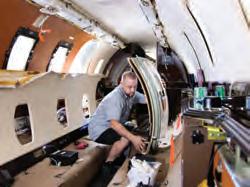



Elbit Systems of America (Booth 4269) is bringing its wide range of aircraft sustainment and support services, and advanced cockpit instrumentation this week to NBAA-BACE, focusing on the multinational aerospace and defense company’s busi ness aviation portfolio. A sub sidiary of Israel’s Elbit Systems, the Delaware-based company is an FAA-certified repair station for radio, airframe, powerplant, accessories, and instruments, supporting AOG, drop-in, and heavy maintenance needs, offer ing structural repairs, engineer ing, field team support, and modernization programs.
The company is also high lighting its technicians’ deep experience in meeting repair
requirements and providing the resources to produce the test pro cedures necessary for approvals from government and commer cial agencies. Avionics and elec tronics repair capabilities extend to the line-replaceable unit and shop-replaceable unit levels and are developed “based on customer needs and urgent requirements in pneumatics, hydraulics, and elec tro/mechanical systems,” the com pany said.
On the flight deck, Elbit offers a line of advanced air data products, instrumentation, commercial air craft services, head-up displays, and vision systems. Its ClearVi sion enhanced flight vision system (EFVS), sold by sister company Universal Avionics, enables air port accessibility in low-visibil ity conditions. Comprised of the SkyLens head-wearable display

and next-generation multi-spec tral enhanced vision system, it is suitable for both new and retrofit applications on business aircraft.
The supply-chain-management team’s ability to support aging aircraft can be especially valu able in today’s disrupted sourcing environment. Elbit has also long been known for its maintenance,
repair, and overhaul expertise in the Fairchild Swearingen Merlin and Metro turboprops.
Elbit’s logistics capabilities include engineering support, spare and repair parts iden tification, facilities, material, and equipment.
For helicopter operators, Elbit offers recurring scheduled main tenance, mechanical component repair and overhaul, and avionics repair and upgrades, as well as complete modernization services aimed at “increasing the capabil ities of current rotor fleets, and minimizing the constraints of complex terrain and higher alti tudes,” the company said. Work can be performed at Elbit’s facil ities, in the field, or at customerspecified locations.
Parent company Elbit Systems has also developed a product from its defense business that is finding more demand in business aviation: its Multi-spectral Infra red Countermeasures (MUSIC)
Directed IR Countermeasures (DIRCM) systems, which are designed to protect aircraft against man-portable heat-seeking anti-aircraft missiles. These mis siles pose a serious threat to com mercial aviation and VIP aircraft, security experts say, and their global proliferation has increased significantly in recent years.

Elbit’s MUSIC DIRCM com bines advanced fiber laser technology, a high-frame-rate thermal camera, and a small, highly dynamic mirror turret to counter these threats. The sys tems are lightweight, compact, and easily installed on a broad range of aircraft, including execu tive airliners and large-cabin busi nesss jets.
In July, the Netherlands ordered a MUSIC and electronic warfare system for a Gulfstream G650 operated by its Ministry of Defense. Completion centers have also reported installing the units on aircraft for private and government clients. z

Lufthansa Technik (LHT, Booth 2881) is making strong progress on its “journey toward the future,” mapped along a route of incremen tal innovation, and it’s inviting NBAA-BACE attendees this week to see and experience some of the advances for themselves. The evolution of LHT’s cabin-management system (CMS), Nice (for network integrated cabin equipment), and sustainability initiatives are in the spotlight, said Wassef Ayadi, LHT’s senior director of customer relations, OEM, and special engineering services.
Many of these technologies have been suc cessfully installed in VIP aircraft cabins, he noted, “but we would like to show that all this innovation may also fit into a smaller aircraft.” A mockup of a cabin section at the LHT booth serves as the demo platform for some of these technologies, anchored by the latest version of the company’s Nice CMS. It’s standard equipment on Bombardier’s Challenger
3500, which entered service last month and is making its NBAA-BACE debut this week at the static display (AD_310).
The upgraded Nice CMS features advanced artificial intelligence-driven voice command for controlling cabin equipment, reflecting LHT’s goal of bringing home- and officelike experiences to the sky. But unlike other voice-recognition systems, Nice voice com mand requires no internet connectivity—all the software is self-contained in the CMS. LHT is continuing to develop the library of commands the multilingual system can handle.

But the biggest change to the system is occur ring on a larger scale now, with its evolution to the NiceOS “customer-centric and cloud-based open software platform.” According to Ayadi,
“It’s an open-platform concept. The scenario we are heading toward is purely a software change, like what is happening in the iPhone world.”
While next-gen CMS hardware will be introduced as major technological advances warrant, all interim upgrades will be softwarebased and apply to current and recent gen erations of Nice. For end-users, the evolved Nice will support customization and remote system configuration via the internet, allow ing OEMs and operators to create their own branded versions of the CMS and change configurations in-flight or for select flights. This will provide “individualized experiences within the cabin environment,” he said.
As in his iPhone analogy, “Clearly the older systems wouldn’t be quite as robust if the device doesn’t support a feature,” said Ayadi. “But this will ensure you have the latest operating system and a reasonable set of functions.”


Within the mockup, a small virtual cabin environment allows visitors to don virtual reality devices and try activating cabin systems.
Technology integration in the cabin includes a curved OLED screen set in a wall-mounted structure composed of lightweight recyclable materials, created in collaboration with Aus trian interiors specialist F/List.
Aeroflax, another collaborative creation on display at LHT’s booth, is a flax-based replacement for glass-fiber or carbon-fiber parts such as sidewalls and ceiling panels. LHT developed the renewable, lightweight material—comprised of flax fibers and biological resin—with German MRO Bcomp. Flax is easy to grow, and the fabric has a low density and good mechanical properties, LHT noted, while providing a 20 percent weight savings over glass- or carbon-fiber. It also meets flammability standards thanks to a proprietary mix of flame-retardant additives.
Meanwhile, the skin on the model of the “shark” on display is actually LHT’s indevelopment AeroShark drag-reduction coat ing. Applied as a bionic film, AeroShark mimics the hydrodynamic drag-reducing properties of shark skin. By optimizing airflow, the coating has the potential to cut fuel consumption by up to 1 percent, according to LHT, reducing both costs and carbon footprint.
LHT is also considering the interior of tomorrow’s eVTOLs and air taxis, and the technologies on display this week at NBAABACE are already giving the company a head start on defining the look, feel, and functionality, said Ayadi. “You can use all these blended, curved screens around that environment.” z

National Transportation Safety Board (NTSB) member Michael Graham is concerned that perceptions regarding safety management systems (SMS) are deterring small operators from adopting such programs. Graham, a former U.S. naval aviator who chaired the Air Charter Safety Foundation and was director of flight operations safety, security, and stan dardization, noted that “there’s a misconcep tion that [safety management systems] are going to be very time-consuming. It’s going to be a lot of work that’s going to be wasted and it’s going to cost a lot.
“We need to get that perception erased in the industry, said Graham, who is set to partici pate on Thursday in a panel on scaling safety management systems for business aviation. “In my perspective, it’s not costly and diffi cult. It could be very simple, especially for small operators.”
Graham noted uncer tainties surrounding the FAA’s looming proposed rulemaking that will expand SMS regulations to charter and maintenance organizations. He added that the fear is the FAA will simply apply the existing Part 5 regulations written for Part 121 to other operators.

“Unfortunately, there’s not a lot of good information on what scalability looks like [under Part 5], and that’s why I have focused on and talked about what SMS for a smaller operator could look like,” he told AIN.

The NTSB’s Most Wanted list includes SMS for all passenger revenue-carrying operations, but the agency also wants the programs to be verified for their effectiveness by the FAA, he noted.
“We’ve asked for the FAA to give some guidance to the smaller operator on what an SMS would look like. I think it’s the fear of the
unknown that is scaring a lot of these oper ators. It’s up to the industry to promote SMS on every level.”

Even with the uncertainty surrounding SMS rulemaking, Graham is a strong believer in their implementation. “You’ll hear from not just board members, but a lot of our investigators, that we’re not seeing any new accidents out there,” he said. “It’s a lot of the same thing over and over again. A lot of operators are not managing their risk and a lot of them don’t have SMS. That’s why we’ve been pushing this really hard since 2016.”
In many accidents, operators are not iden tifying hazards and risks, Graham continued. “They may have good policies and procedures in place, but operationally they’re not assuring that those policies and procedures are being followed or if there are issues with them. A lot of times, there are known risks that aren’t being eliminated or mitigated. That’s why we call on SMS. It comes from the top, but SMS engages every single employee in that operation.”
Graham will be part of a panel tomorrow from 9:30 to 10:30 a.m. at the NBAA Safety Education Center. Moderated by NBAA’s Doug Carr, the session will also feature Andrew Karas from the International Business Avia tion Council, Bob Rufli from the Air Charter Safety Foundation, and Amanda Ferraro from Aviation Safety Solutions.
Reimagine your place in the sky 12 hours and 5,650 nautical miles of non-stop performance. The ACJ TwoTwenty has reimagined executive and private travel. For a similar investment, enjoy twice the space of any other large cabin business jet and lower operating costs.

Engine Assurance Program has signed its 250th engine, a Honeywell TFE731 that powers a Dassault Falcon 900.

Engine Assurance Program (EAP, Booth 1841) has enrolled the 250th engine or APU—a Honeywell TFE731 turbofan—in its business jet hourly maintenance program. In addition, it is expanding the program to include the Honeywell CFE738 engine and 36-150F2M APU that power the Dassault Falcon 2000, the
Dallas-based company announced on the eve of NBAA-BACE 2022.
The milestone TFE731 powers a Falcon 900B trijet. EAP founder and program coor dinator Sean Lynch told AIN that the 50-yearold turbofan family represents the single biggest engine type covered by EAP.
Meanwhile, the addition of the CFE738 engine and 36-150F2M APU builds on EAP’s
coverage of all variants of the Honeywell TFE731, as well as most GE Aviation, RollsRoyce, and Pratt & Whitney Canada turbofan engines. There are 230 Falcon 2000s in ser vice, with 70 percent of them operating in North America, according to EAP.
Launched in 2016, EAP offers hourly maintenance coverage that Lynch said is equal to an OEM’s highest-level hourly maintenance program. Its program covers scheduled and unscheduled maintenance, including lifelimited parts, line-replaceable units, removal and reinstallation, shipping, rentals, line maintenance, trend monitoring, and cata strophic coverage.
“Our business model is that we focus on older engines,” Lynch said. “We only focus on older engine platforms. We take whatever the manufacturer’s top-tier coverage is, and that’s what our product is.”
For EAP-covered engines and APUs, maintenance is provided by several OEMauthorized MROs and OEMs such as Duncan Aviation, StandardAero, GE Aviation, and Rolls-Royce, Lynch explained. EAP’s program has a 99.99 percent dispatch reliability rate.
In addition to its hourly maintenance pro gram, EAP has about $10 million in spare parts, rental engines, and APUs that it houses in a facility north of Dallas. “It’s a robust part of our business model,” Lynch said. “We’ve never ever had a customer not get a rental engine when they need one.” z
In 2021, nearly a third of AviationManuals’ clients identified lack of recency as a risk factor for their operations, according to data ana lyzed by the flight department manual and safety services specialist. Lack of recency among pilots occurs when they haven’t been flying for a period and may miss performing tasks once they return to the flight deck. “It’s just basic things like memory items,” AviationManu als senior adviser Kevin Honan told AIN, “and they need a little bit of refreshing to get back up to speed and make sure everybody’s safe.”
He suspects that much of the lack of recency issue centers around the Covid-19 pandemic, which idled a lot of Part 91 and 135 aircraft for several months.
Data for the analysis came from AviationManuals’ flight risk assessment tool that is a part of the company’s ARC safety man agement system (SMS) software. Specifically, the information was culled from 17,000 risk assessments submitted through the system.
“We worked with operators and pulled the information from our riskassessment tool to see general trends on this data, see where we could help them come up with mitigations for it,” Honan added.
Some flight departments have policies to pair less-experienced captains with more-experienced pilots to overcome lack of recency. “It’s almost like a mentorship program. They come up to speed under that experience,” he said.
But not all flight departments have the same resources. For smaller operators, another means to alleviate lack of recency is to climb onto the flight deck and run through departure and arrival pro cedures in a simulated environment. There are other steps that flight departments can implement as well. One is to plan daytime depar tures and avoid flying at night “when there’s a circadian low,” Honan said. Another is to take extra time on preflight briefings, spending “a lot more time to just make sure you’re checking all the boxes.” J.S.
























































































































































































































Milan, Italy-based SEA Prime’s FBO facilities at Linate and Malpensa airports saw a 42 per cent year-over-year increase in business aircraft movements in the first eight months. This also represents 154 and 29 percent increases from the same periods in 2020 and 2019, respectively.
“Last year, we saw more than 27,000 movements at the two airports combined and we expect to reach over 30,000 movements this year,” said SEA Prime CEO Chiara Dorigotti. The company operates these airports under its Milano Prime brand.
“January to August is looking extremely good and [we saw] a good September because of all the events happening in Milan,” Dorigotti said. “At the Formula 1 Grand Prix on September 9 to 12, reported increases in the number of race spectators over the week end—336,000, compared with 200,000 in record-year 2019— were accompanied by an increase in movements managed by SEA Prime of 54 percent compared with 2019, while 75 percent of managed air traffic was international.”
Dorigotti also expressed plea sure with the turnout at EBACE 2022. “It was well attended,” she commented. “We were happy to meet in person as we did in the U.S. in April at the NBAA Sched ulers and Dispatchers event in San Diego. This was our first business aviation-related event in some time. In fact, we were also in Dubai in November 2021 for the airshow, which attracted a lot of business aviation exhibitors.”
Milano Prime claims to be an important gateway to

international and sporting events in Milan, which include soccer’s Champions and Nations Leagues and basketball’s EuroLeague.
“Even though fuel prices and economic and political uncertainties may have a potential impact, we expect to close this year with solid double-digit growth,” Dorigotti said. “We are looking very carefully at higher fuel prices and war-related uncertainty. In terms of traffic trends, in 2021 we have seen a slight change, in the sense that, versus last year, we have had more international and less domestic traffic.
“We’ve been seeing more inter continental traffic,” she contin ued. “Flights from and to North America are up 200 percent ver sus last year.”
Regarding airport operations, a shortage of personnel has impacted business in general in Italy. Regulations on employee subsidies meant people were, for the most part, not actually laid off but frozen in furlough schemes. However, handlers have managed to get their personnel back.
“As a result, we have not seen
meaningful operational challenges,” Dorigotti remarked. “We can man age traffic well, and fuel is available. The fact that business has recov ered has not impacted numbers, but it’s impacted the mix. Domes tic flights have decreased because more people are traveling abroad due to easing restrictions on inter national travel.”
SEA Prime’s growth remains higher than Europe’s, overall. Cit ing WingX data, Dorigotti said Europe had been growing at 18 percent this year through July. “In comparison, we have been growing at 35 percent,” she noted. “Milan is still the key business aviation air port for traffic in Italy today. In July, Italy was Europe’s third-largest market. Inland represents a signifi cant share. Of course, in August, we saw a lot of traffic in holiday loca tions, like the islands or the south.”
Linate has higher traffic vol umes; Malpensa Prime has fewer flights, but bigger aircraft sizes. Malpensa is more of an inbound airport, typically for traffic from North America and the Middle East, being close to Lake Como and Lake Maggiore.
“We also see bigger aircraft around Malpensa Prime because
they have two runways that can accommodate BBJs and ACJs,” Dorigotti said. “When we designed it, we targeted a differ ent type of traffic. It’s also close to Switzerland and Lugano [Italy] and to a number of winter sports destinations in northern Italy. In Malpensa Prime, we also host a number of flights, particularly for sports teams, and music bands.”
The sole FBO operator in Milan, SEA Prime’s ownership is a public-private mix. It is held 100 percent by the commercial air port manager at Linate and Mal pensa, SEA, the second- largest commercial aviation operator in Italy. In turn, SEA is 51 per cent owned by the municipality of Milan, with the balance being held by two private equity funds.
Immediate expansion plans put infrastructure at the focus of development. SEA Prime runs 10 hangars in Linate Prime and a large one at Malpensa Prime. It is adding an 11th at Linate, a maintenance hangar consolidat ing and expanding the Bombar dier authorized service facility managed by Directional Aviation Group’s Sirio.
Longer term, Dorigotti said, operators required a concession from the government to be eligi ble to be airport managers in Italy. Its indirect shareholder owns other Italian airports, including Naples, Olbia, and Turin. “In my view, it could be interesting to develop a network of busi ness aviation airport managers exploiting commercial and oper ational synergies,” she said.
“There is definitely organic growth potential where we are, in Milan, our focus today,” Dorigotti concluded. “However, if new opportunities materialize, and if tenders are issued, we will look at them. Our shareholders will ultimately decide growth strategy and capital allocation but we will be potentially active if opportunities arise in Italy and, potentially, abroad.” z
With our TIOS+ solution, we look back on more than 20 years of in-house experience in the design, development and manufacture of radomes. TIOS+ offers you the choice of multiple antenna system combinations, including the latest OEM antennas and HD cameras.
Now you can enjoy live TV, high-speed broadband Internet access, high-quality voice calls and much more. In addition, TIOS significantly reduces drag, weight, and operating costs in comparison to fuselage-mounted systems, and – with its elegant and clean design – blends perfectly into any aircraft.


While rising interest rates and real estate prices have had adverse effects on consum ers in the U.S. economy, the business aviation travel industry continues to show positive growth, Mohammed Al Husary, co-owner, founder, and executive president of UAS International Trip Support (Booth 2085) told AIN on the eve of NBAA-BACE.
“If there is pessimism, we’re not experienc ing it in our interactions,” he said. “U.S. companies seem to be taking a cautious approach, and we don’t anticipate any extreme move ment until after the U.S. [mid-term] elections. Our clients still demand the same high stan dards and are not willing to compromise on their operations safety, security, efficiency, or flexibility.”
Many of the newcomers to business avi ation post-pandemic are passengers opting for more safety and efficiency and to escape inconvenience at airports, Al Husary believes. Airline flight cancelations and airport congestion have also been major contributors to an increase in demand for business and private jets, and this will continue as the Covid-19 situation and its repercussions continue to cause staff shortages at both airlines and airports.
“A more long-term economic slowdown and higher interest rates could tamp down the record demand slightly but given the lead time to acquire the assets, unless there is a significant downturn, demand should remain fairly strong,” he said.
According to Al Husary, supply chain disrup tions to OEM output had been exacerbated by the Russia-Ukraine War. “The industry is still experiencing delays and supply shortages due to supply chain issues, whether for aircraft or parts. And, of course, it is creating headaches for stakeholders globally,” he said. “There has never been so much more demand than there are aircraft, and it is frustrating for some charter brokers not to be able to offer their clients as wide a choice as they would like.”
He said the new and preowned business air craft segments remain strong, with both sectors reporting robust demand. “Our understanding is that a significant amount of movement has been with the preowned market due to delivery delays reported with OEMs,” he said. “We have experienced an increased number of deliveries to the U.S. from overseas to help fill the demand. Undoubtedly, fractional ownership is a growing trend, while corporate jets are also extremely strong and showing positive sustainability.”
One development he identified as being unhelpful was the number of illegal charters operating internationally into the U.S., claiming they operated under the Federal Aviation Regulations for fractional-ownership schemes. Part 91 Subpart K governs these operations.
“According to our Americas team, there are currently only 10 true fractional oper ators that are legally bound under Part 91K. [Recently], U.S. Customs and Border Protec tion (CBP) began the penalty phase for three charter providers in three days and inter cepted a fourth. Many of these operators ‘port shop’ clearance locations and are often found to have coached their passengers as to what to tell CBP officers during inspections. It seems the CBP is making a great effort to reign in these illegal operators.”
A clarification from a UAS spokesperson explained that “port shop” refers to operators calling around to various customs airports to see who will “accept” them for clearance. They specifically are looking for locations that do not necessarily follow the rules, allowing operators to evade certain processes.
UAS launched its Americas headquarters in Houston, Texas, nine years ago, and since then its operations team has been supporting clients in North and South America through its global network. More recently, it has expanded its teams of on-site supervisors across airports in the U.S., Mexico, Brazil, and Colombia.

“Demand for this type of dedicated support is on the rise because current travel condi tions have created shortages in many FBOs and airports,” he said.
He claims UAS’s latest advanced tech nology—Global Trip Manager (GTM)—is the fastest, most powerful trip management system on the market. GTM provides realtime updates and information on all service requests globally, so operators have the power to manage their trip-planning needs, as well as their company profile, including personnel, contacts, fleet, and documentation.
GTM features include real-time tracking of requests, on-demand flight status checks, flight briefs, fuel releases, and operational and technical information for airports worldwide. “It’s been designed to give the user something they have never seen before, as well as more power and more freedom,” he said. “It can overcome the major and minor pain points that operators experience and give them total and immediate control of trip planning activities in the most comprehensive way yet.” z
“Demand for this type of dedicated support is on the rise because current travel conditions have created shortages in many FBOs and airports”
Mohammed Al Husary, co-owner, founder, and executive president of UAS International Trip Support

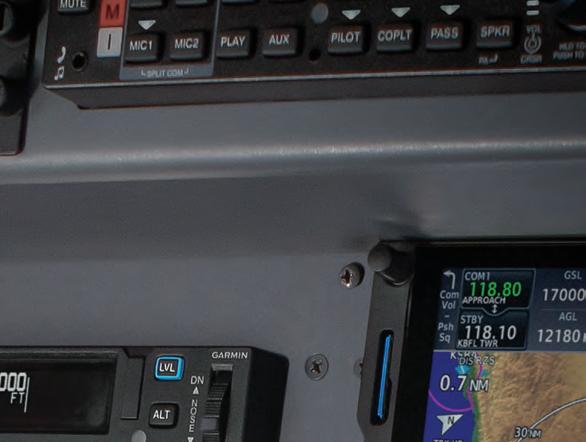








Aircraft broker Jetcraft is predicting that preowned business jet transactions will dip slightly this year and then rise at a 3.6 percent compound annual rate until yearend 2026, according to its latest Five-Year Pre-Owned Business Jet Market Forecast, released last month.

“This year’s report predicts that, after stabilizing in the wake of a post-Covid surge, preowned transactions should maintain their new higher base and growth rates, reaching 10,921 transac tions valued at $66.6 [billion] over the forecast period,” said Jetcraft CEO Chad Anderson.
Last year’s preowned jet transactions reached a record value of $14.5 billion, a nearly 40 percent increase from 2020, primarily driven by midsize and large-cabin jet purchases, the company said. Despite an equally strong perfor mance earlier this year, Jetcraft expects the market to soften,
with normal depreciation levels resuming in 2023.
Jahid Fazal-Karim, owner and chairman of Jetcraft, said in the report that the market has not yet returned to pre-pandemic norms and the industry is still “in an opportunistic position.” However, it is trending more toward “nor mality,” Fazal-Karim added.
“When compared to 2020, it might feel as though prices are rising at an unstable rate,” he said. “Our data, however, indicates this is a rational market, with value
growth expected to return to pre-pandemic levels.”
Unlike the time between 2004 and 2007 when the preowned market experienced 50 percent average price increases, the current period has pricing that reflects short-term world events and remains “far more rational” with average prices returning to pre-pandemic levels, according to Jetcraft.
North America has led growth in demand for preowned aircraft, with its market share growing
from 53 percent in 2010 to 73 percent in 2021. Even so, Jetcraft identified international growth areas in the report, noting that the ultra-high-net-worth popula tion in Asia-Pacific—a region that prefers large-cabin jets—is set to increase 33 percent over the next five years.
The study reports that the share of preowned jet buyers under age 45 has risen 20 per cent since 2017 and notes that the younger age group is trend ing toward larger aircraft with an average transaction price of $25 million. This is 31 percent more than the over-45 demographic.
“Shifts in buyer behavior con tinue to fuel this upward tra jectory with more and younger first-time buyers entering the market, greater demand for larger jets, and a growing ultrahigh-net-worth population. And we’re now entering a postpandemic business cycle from a new, higher starting point,” FazalKarim added.
By model segment, preowned transactions for large aircraft are expected to dip from 419 aircraft in 2021 to 368 this year. However, they will grow steadily each year thereafter, exceeding 2021 levels by 2024, and reach ing 483 by 2026.
Midsize aircraft transactions will experience a similar yearover-year slide, from 573 in 2021 to 507 this year, but grow at a slower rate, exceeding 2021 lev els in 2026. Light aircraft, how ever, are forecast for the biggest drop from 1,427 preowned trans actions last year to 1,119 this year. They are not expected to return to 2021 levels over the forecast period, ebbing upward to 1,240 by 2026.
Market value is projected to have peaked in 2021, dipping to $13.7 billion this year and then $13 billion next year. Growth in pric ing is anticipated to be uneven and slower after that, but not to return to 2021 levels before 2027. z
“This year’s report predicts that, after stabilizing in the wake of a post-Covid surge, preowned transactions should maintain their new higher base and growth rates.”
Jetcraft CEO Chad Anderson
We are humbled by being rated number one in AIN’s annual engine support survey. Thank you to all our customers who continue to trust in our commitment and passion to keep you fying.


Here’s to continuing our amazing journey, together.
The aircraft cabin plays a key role in business aviation’s sustainability push for reasons extending beyond bottom-line economic benefits. And it’s a part that OEMs and MROs, their vendors, interior designers, and customers are increasingly embracing.

“If we’re going to move our industry and soci ety in the direction of sustainability, it’s going to involve the sum of small things,” said Vadim Feldzer, Dassault Aviation’s head of global communications. “That’s where improving the sustainability of the cabin comes in.”
Now, metrics to quantify cabin sustainability are being developed and a new generation of bio-based materials are being deployed, signaling growing momentum for green interiors. If less ballyhooed than technological advances, perhaps it’s not the more modest footprint reductions that sustainable cabins achieve compared to, say, a new-generation power plant, but rather because aircraft interiors have been largely sustainable for some time.
“We’ve been offering sustainable premium textiles, wood, stone, and naturally sustain able fibers for decades,” said Christi Tanna hill, Textron Aviation’s senior v-p of customer
experience, citing the wool, cotton, linen, silk, mohair, bamboo, and leather common in Textron’s and other OEMs’ cabins.
In its Savannah, Georgia production facili ties, “Sustainable materials are used throughout Gulfstream interiors,” said president Mark Burns, singling out traditional fabrics, along with natural latex and composite veneers, “all of which can be derived from renewable resources.” Furthering cabin sustainability are the largely recyclable components.
“Cabinets are mostly aluminum honeycomb, and can be fed directly to a smelter,” Burns said. “Natural fibers such as silk or wool can have second lives as jute, rags, or feedstock for paper mills, while synthetics such as nylon and polyester are sought after by carpet mills to use as feedstock to create more carpet.”
At Bombardier, Global and Challenger cab ins feature “a range of upcycled and engineered soft goods made from reclaimed or natural fibers,” said Laurence Casia, manager of indus trial design and cabin innovation, many of them showcased on its super-midsize Challenger 3500. The rapidly-renewable wood option for cabin surfaces and more locally sourced fiberbased materials “are often more durable and lightweight” than those they replace, he said.
In addition to the fabrics, wood, vegetaltanned leathers, and other renewable and environmentally friendly materials through out Dassault Aviation’s Falcon cabins, the forthcoming flagship Falcon 10X is designed with modular interior elements to enhance sustainable maintenance. “If there’s an issue with a cabinet, for example,” said Feldzer, “It’s easy to repair or modify without having to replace substantial interior components.”
Sustainable materials are entering a “super natural” era, uniting them with tech nology and opening new frontiers in design and sustainability.
Austria-based F/List, long known for its innovative, bespoke interior components and outfittings for luxury residences and super yachts, as well as high-end jet cabins, is “now diving into a lot of sustainability elements,” said innovation head Melanie Prince.
Internally and in partnerships, F/List is creating “a portfolio of stuff that actually works, and that is actually sustainable,” Prince said. Some mimic and match the look and feel, while outperforming, less sustainable high-end materials—for example, the hides and skins of undomesticated animals. Mean while, the bio-based material underlying its Shapeshifter technology, debuting this week at NBAA-BACE, brings to the cabin dynamic movement that can alter interior spaces.
Germany’s Lufthansa Technik, which has introduced recent innovations including voice command in cabin management systems and ultra-thin curved OLED screens that save weight and energy, is adding sustainable mate rials to the list, including its new AeroFlax. A flax-based replacement fabric for glass or carbon-fiber parts such as sidewalls and ceil ing panels, AeroFlax offers a 20 percent weight savings and meets flammability standards.
While demonstrator models can serve as stateof-the-art sustainability showcases, “concept cabins” allow OEMs and interiors specialists to introduce novel ideas and applications, and judge market reaction and practicality before offering them to customers.
A concept for the Praetor 500/600 from Bra zil’s Embraer envisions “a multidimensional sustainable interior,” incorporating, in addition to sustainable natural materials, design ele ments based on the Japanese art of “Mokumegane,” a technique for creating mixed-metal laminate from discarded materials—including, continues on page 32

in this case, titanium, copper, and plastic—for cabinetry and other cabin surfaces.
“Affinity,” a widebody cabin concept cre ated by Boeing completion specialist Green point Technologies, integrates biophilic, or human-nature-centric design and organic materials, with innovative technology. Setting the tone, expansive OLED screens host live feature walls that display nature scenes, illu minated by circadian rhythm-aligned lighting.
Basel-based Jet Aviation, already commit ted “to offering our customers a range of sustainable choices,” said v-p of completions sales and marketing Matthew Woollaston, intro duced this year a VIP cabin concept—dubbed “Mink”—that includes table marble marquetry made of stone offcuts, complementing the natural fiber fabrics and flooring made from recycled materials. The MRO is concurrently investigating additional materials for use in its ongoing completions and refurbishments, including plant-based leather alternatives and water-based paints. These materials “enhance cabin sustainability without sacrificing the look, feel, and quality,” said Woollaston.
If Woollaston’s comment raises the
question of whether luxury and sustainabil ity can co-exist in the business jet cabin, the response from the frontlines is uniform.

“Sustainability, quality, and craftsmanship are without a doubt compatible,” said Gulf stream’s Burns, adding, “Natural materials at their best are typically also the finest.”
Tannahill pointed out that cabin materials are selected first for their natural properties. The sustainability test is the ultimate, not primary criteria.
“Wool is sound-dampening and naturally flame-resistant, and cotton, linen, silk, mohair, and bamboo are also naturally flame-resistant,” as well as durable and luxurious, she noted.
The one outlier among the sustainable natural elements in the cabin is the signature polished hardwood veneers, long standard in high-end interiors and traditionally sourced from slow-growing, exotic, or endangered tropical hardwoods. Today a variety of sus tainable veneers and other cabin surface options are available.
Aircraft such as the Citation XLS Gen2 are adopting more sustainable materials in their cabins.

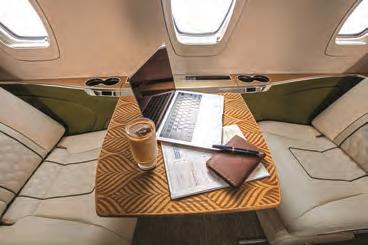
Said Casia at Bombardier, “We’ve demon strated that sustainability doesn’t mean hav ing to make any compromises.” The greener elements, he added, “are as comfortable and luxurious as they are sustainable, and as light and beautiful as traditional materials.”
Comlux Completions is among those that use reclaimed and repurposed veneers to create new ones. “You cannot tell the difference between these reclaimed products and tra ditional veneers,” said company CEO Daron Dryer, noting that the repurposed product is available as an option on the ACJ TwoTwenty.
Challenger and Global cabins offer hard wood veneer made from fast-growing eucalyptus trees, cutting carbon dioxide byproducts by 43 percent and water consumption by 94 percent over traditional veneer production.
Dassault’s multiple alternatives to stan dard veneer include an in-house process that reduces varnish applications and applies a paint finish over sustainable wood. At Textron, the composite veneers in Cessna Citation and Beechcraft cabins are made “by using every scrap of veneer left over from a ‘green certi fied,’ responsibly harvested initial veneer,” Tan nahill said, with the pieces laminated together to “create a new, modern grain pattern.”
When natural veneer is used, she added, it’s sourced from “high-quality surplus inventory when available to minimize new-production processing efforts.”
Customers in the aftermarket can opt out of veneer and choose an entirely different surface look.
MROs Duncan Aviation and Liberty Part ners offer hydrodipping, a process that shrink wraps a detailed, 3D image replicating the look of any material—or a scene or artwork— onto almost any complex, solid shape. A hydrodipped cabinet, for example, after the film is applied in a dunk tank, can mimic an exotic veneer or carbon fiber surface indis tinguishable from the real McCoy or just as easily showcase artwork or a fanciful tableau, providing more options for demonstrating individuality, as well as sustainability. z

Pratt & Whitney Canada (P&WC, Booth 2835) launched its Ser vices Hub on Monday at NBAABACE as a new self-serve digital tool designed to guide custom ers online through the process of selecting the right P&WC
maintenance services and solu tions for their engine, aircraft model, and lifecycle stage. The company has more than 70 after market offerings to support its 66,000 engines in service, and the tool will help customers quickly find what they need.
Using Services Hub, customers
are guided through a series of brief questions identifying the aircraft, engine model, and engine total time since entering service. Services Hub then dis plays the most applicable main tenance solutions and services tailored to the customer’s engine and lifecycle stage.

“Services Hub is a part of the ongoing aftermarket digital trans formation at P&WC to enhance the customer experience,” said Irene Makris, v-p of customer service. “Acting as a personalized online concierge for customers,
Services Hub enables them to rapidly filter and identify the prod ucts or services that are right for them. Another benefit of the tool is that it helps pair customers with a P&WC sales manager in their region who can answer any further questions about our services and provide individual guidance.”
P&WC also announced that a second MRO facility for its PW800-series engines will open in Berlin-Brandenberg, Germany, in 2024—in cooperation with long-time collaborator MTU Aero Engines. This collaboration with MTU builds upon P&WC’s $30 million investment in its Bridge port, West Virginia facility to create the first PW800 MRO.
United States Aircraft Insurance Group (USAIG, Booth 2620) is celebrating 45 years of creating and distributing safety posters and other safety resources for the aviation industry. Founded in 1928 and the nation’s first aviation insurance company, USAIG has been working with partner organizations to provide safety posters to the aviation community free of charge since 1977.
Starting in 2013, USAIG began printing the posters in quarterly print issues of AIN , reach ing 38,000 subscribers in 155 countries. In 2016, USAIG started producing the safety posters as screensavers and desktop wallpaper formats.
Over the years, USAIG’s safety posters have covered a variety of topics, ranging from runway hazards to safe handling of lithium-ion batteries, as well as the challenges faced by pilots and ground personnel. The posters help to maintain safety management system (SMS) standards across organizations “by keeping safety top of mind, thereby reinforcing an overall safety cul ture,” USAIG said.
In addition to its safety posters, USAIG pro motes SMS compliance by publishing a quarterly newsletter called Premium on Safety , which explores issues such as flight department man agement, pilot experiences, and regulator updates.

The insurance provider also supports SMS processes through its Performance Vector safety initiative, which allows policyholders with tur bine aircraft to select annually from a portfolio of training and safety-enhancing services. Since USAIG launched the Performance Vector initia tive in 2011, it has continually updated the suite of program options to keep up with ever-evolving aviation safety protocols.
“Performance Vector aims to meet the operator where their safety program needs are and help them confidently align with leading safety criteria and industry best practices,” USAIG said.
Program options include training needs assess ments, airplane upset and recovery training, crisis response services, and tools for fatigue and safety risk assessment and management services. H.W.
The PW800-series engine powers the Gulfstream G500 and G600, which entered service in 2018 and 2019, respectively, and was selected for the G400. It is also the powerplant for the Das sault Falcon 6X, which is expected to enter service next year.
P&WC has 50 owned and des ignated maintenance facilities, 100 field support managers, more than 100 mobile repair team technicians, 1,000 spare engines, and 10 owned and designated parts distribution centers worldwide. In November, it expanded its designated maintenance facility network, appointing Jet Aviation operations in Singapore; Cairns, Australia; Hong Kong; Manila, the Philippines; and Basel, Swit zerland, bringing the number of DMFs worldwide to 22.
The company recently expanded its portfolio of P&WC Smart solutions for major main tenance events. The first new offering under the category is the P&WC Smart subscription service for PT6A engines that provides selected scheduled and unscheduled maintenance cov erage, parts replacement, and digital engine health services for engines that are between their hot-section inspection interval and overhaul.


Online fuel marketplace FuelerLinx (Booth 4332) is debuting new capabilities to its fuel availability maps and its popular FBOLinx soft ware. The California-based company has introduced a sustainable aviation fuel (SAF) search and purchasing option to its software.
SAF is a crucial component in the industry’s growing e orts to decar bonize, and the addition to the FuelerLinx system will help alleviate problems in sourcing and pricing the renewable fuel. On its online maps, sustainable options will be highlighted with green leaf icons.
“The addition of SAF is a key moment in the evolution of our software, and it underlines FuelerLinx’s commitment to helping our clients on their path to the industry’s net-zero goal,” said company president and CEO Kevin Moller. “Fuelerlinx transacts over 50,000 purchases each month, all of which will now have the ability to find and price sustainable options.”
In addition, the system will produce analytics so customers can track and see where further carbon o sets will be required, according
to Jessica McClintock, v-p of global account management. “This level of insight makes Fuelerlinx’s customers better informed and able to manage their fuel purchases and tankering decisions,” she said.
FuelerLinx has also enhanced its FBOLinx subscription product. The improved portal will give its FBO customers the ability to analyze and target flight department demand through data derived from the company’s thousands of fuel transactions each month and 14 years of industry tracking. As part of the FBOLinx o ering, each customer loca tion receives a 300-nm-range ADS-B receiver, which will alert the FBO when an inbound aircraft with a fuel order is in range. The system will then transmit the flight operator’s requested fuel volume and services required along with its contract fuel program.
Other features include a contact resource manager, airport geofenc ing to track aircraft ground movement, customer conversion rates, fuel volume data, and historical aircraft movement information. C.E.
Textron Aviation is putting a big emphasis on aftermarket service and customer support at this year’s NBAA-BACE, announcing an expanded parts operation and a new satellite service center in Dallas.

In a move to address growing demand and increase efficiency, Textron Aviation (Booth 1273, Static SD_502) will nearly triple the size
of its Wichita parts warehouse and distribu tion center by adding 180,000 sq ft to the company’s existing 65,000-sq-ft warehouse.
Construction is expected to take 12 to 18 months and be completed in fourth-quarter 2023, senior v-p of parts and programs Kriya Shortt told AIN
The expanded facility will provide space for larger parts such as wheels and windshields and allow the company to consolidate those larger
parts from its eastside to its westside cam pus. It also will accommodate the higher parts demand that the airframer has experienced fol lowing its earlier initiatives to improve access to parts by way of a website and to adjust pric ing to the market.
“We’ve made a lot of effort over the past two years to…have the right parts in stock, to be priced to the market, and make it easy to do business with,” Shortt said. “We certainly have seen as we have that value proposition and we are executing to that, we’ve seen vol ume growth. So we want to make sure we can continue to earn that business from our cus tomers. We want to be front of mind for them when they’re thinking about parts support.”
Also, by the end of the year the airframer will establish a new satellite service center at Dallas Love Field (KDAL). The 12,000-sq-ft satellite center will offer unscheduled maintenance and AOG service as an extension of its factory service centers in Houston and San Antonio.
Textron Aviation’s Dallas satellite service center will also serve as the operations hub for nine of the company’s mobile service units.
The KDAL operation will additionally serve as the operations hub for nine mobile service units, as well as others positioned throughout Texas. More than 20 technicians will be based at the center. “Dallas is an expanding market for locally based customers flying Textron Avi ation aircraft, in addition to a large volume of transient customers doing business in the area,” said senior v-p of customer support Brian Rohloff. “These customers now have access to local factory direct, expert service and support at our new satellite service center.” z
Dassault Aviation introduced EASy IV, the fourth generation of its EASy flight deck, this week at NBAA-BACE 2022. It features more vivid displays, greater processing power, and added safety features.
“EASy IV will enable [owners and opera tors] to bring their operations up to the latest industry standards and significantly enhance their aircraft value,” said Carlos Brana, executive v-p of civil aircraft for Dassault (Booth 2435, Static AD_204).
Based on a Honeywell Primus Epic system, EASy IV will be standard on the Falcon 6X, which is due to enter service by mid-2023, as well as on all new-build Falcon 8Xs also starting in 2023. It will also be avail able as an upgrade retro fit on earlier Falcon 7Xs and 8Xs.
vertical development. On the ground, 2D/3D airport moving maps give a sharp display of runways, taxiways, ramps, and other airport features, making ground navigation easier at crowded airports and reducing the risk of runway incursions.
Additionally, a new TCAS system includes ADS-B In and Out, enabling pilots to see traffic in the air and on the airport map. Opera tors can also add SiriusXM weather products, which cover all of the U.S., Canada, and the Caribbean, and include graphic and text weather data.
Pilots will appreciate EASy IV’s 2D and 3D depiction of the airport surface.


EASy IV upgrades include an advanced interactive navigation map with improved airspace depiction and terrain resolution, which in combination with a new interactive vertical situation dis play provides a better picture of thunderstorm
Combined with the lat est version of Honeywell’s NextGen FMS, EASy IV also provides new RNP AR approaches for improved access to runways affected by terrain or high-density traffic. Meanwhile, new graphic CPDLC features provide seamless data communications for dif ferent phases of flight.
New Jeppesen chart features are also integrated into EASy IV, including a night mode that keeps an even light level on the flight deck during night approaches and a new panoramic mode with an aircraft symbol georeferenced to approach charts. z
Aevex Aerospace’s supplemental type certificate (STC) for DHC-6-300HG Twin Otter that increases the mtow from 12,500 to 14,000 pounds is now also available for DHC-6-400series aircraft. The upgrade boosts available payload by 1,500 pounds based on an aver age empty weight of 7,700 pounds.
According to Aevex (Booth 3581), the upgraded capabilities apply to aircraft operated in the standard commuter category and equipped with the Garmin G950 NXi/G1000NXi avionics suite. The upgrade also allows utilization of the full 750 shp available from the Pratt & Whitney Canada PT6A-34 engines combined with the e ciency of Raisbeck/Hart zell four-blade Scimitar propellers.
Capabilities of the Garmin system include Required Navigation Performance (RNP 0.3), WAAS/SBAS-certified GPS, and LPV approaches with minimums down to a 200-foot deci sion height and one-half mile visibility.
Aevex provides custom design and engineering, sensor integration and sustainment, aircraft modification and certification, and mission operations services. M.H.
Just 2.5 years after receiving sup plemental type certificate (STC) approval for the XP67A engine on Beechcraft King Air 300s and 350s, Blackhawk Aerospace (Booth 4819) has delivered its 100th pair of the higher-performance engine upgrade. “Our engineering team got this STC done in about 12 to 13 months,” Blackhawk pres ident and CEO Jim Allmon told AIN. “For most companies that do a major STC of this size, it’s a three-year process. Normally we don’t hit 100 on a product line for four or five years.”
The recipient of the engine pair is the Red Bull Air Force, whose recently delivered King Air 300LW is undergoing several modifications and other work in Germany at Augsburg Air Service (AAS), which has been a Black hawk dealer and installer since 1999. AAS managing director Florian Kohlmann said that Red Bull’s King Air also will receive Garmin G1000 avionics, winglets, a new interior, and additions such
as LED annunciator panels and advanced exhaust stacks.
“Our goal is to make it the fast est King Air 300LW in the world,” Kohlmann said. “And it’s such an honor to work with this incredible team at Blackhawk Aerospace and Red Bull, who are supporting busi ness aviation, sports, and passion for aviation around the world.”
The backbone of the XP67A upgrade is Pratt & Whitney Can ada’s PT6A-67A engine, which after Blackhawk’s upgrades pro vides for a 60 percent increased climb rate, more than 332-knot maximum cruise speed, and 62 percent greater payload.
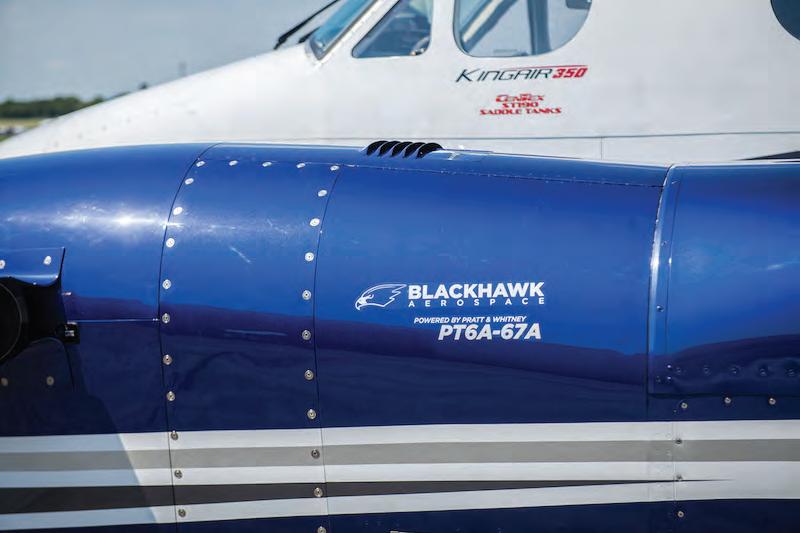
“What we had to do was mod ify the airbox, extend it about an inch and a half because the inlet screen was a little farther back,” Allmon said. “Then we added kind of a little airflow under neath the engine for the oil cooler because we wanted to make sure it cooled the oil properly in the most severe conditions, such as operating in the Middle East.”
The upgrade’s MT five-blade composite propeller allows the
airplane to climb and stop “a bit better.” More importantly, it provides a quieter cabin. “We’ve got a lot of compliments from pas sengers sitting in the back about how quiet it is because you’re only pulling 1,600 rpm in cruise and it’s just so, quiet,” he added.
While the MT propeller is approved on the King Air 350, Allmon noted that Hartzell’s five-blade propeller has been approved for the King Air 300 upgrade in addition to the MT propeller, “which makes that airplane the fastest King Air on the planet. We’re 340 knots plus on the 300 because it’s a lighter, 14,000-pound airframe.”
When Allmon began looking
into the XP67A upgrade, his sales manager and even his partners were skeptical about it because of the pricing “on an engine that’s fairly expensive, upwards of a million-nine plus installation. The engines are a very expensive net to us, and for us to make a reason able profit we had to set a pretty big price for it. But...it’s been very well accepted in the market.”
Since the launch of the XP67A, Blackhawk has added a derivative of the upgrade for military/spe cial-mission King Air 300-series turboprops, called the XR, that adds CenTex fuel tanks and Tex tron heavyweight landing gear.
“We can stay in the air 10-plus hours in loiter mode or we can go about 2,200 nautical miles,” Allmon said. “And you can load up full fuel and still have 2,000 pounds left over for people and payload. So that’s kind of our mili tary version and we’re finally start ing to get some play on that, and I think that will be a big boon.” z
General aviation airframer Piper Aircraft (Booth 4886, Static AD_409) has incorporated the latest updates to the Garmin G3000 avionics suite aboard its M600 SLS single-engine turbo prop. The SLS (short for “safety, luxury, and support”) is on dis play during NBAA-BACE 2022 at Orlando Executive Airport.
According to Piper, the new software upgrades bring enhancements to the aircraft’s synthetic vision system, weather radar, navigation, flight planning, checklists, and the SafeTaxi diagrams that help pilots more easily navigate on airports.
One of the most notable upgrades is the new 3D SafeTaxi, which provides pilots with additional situational awareness on the ground using 3D indicators on the map to depict objects such as airport markers and buildings. A new taxiway routing guidance system has also been added to the SafeTaxi software to further increase pilot awareness. This routing guidance sys tem uses an aircraft’s GPS location and predetermined taxi routes to show the route on the display. The avionics display now also shows a 3D rendering of the aircraft. H.W.
 DAVID M c INTOSH
DAVID M c INTOSH
Honeywell will provide its Anthem integrated avionics suite for Supernal’s five-seat eVTOL. On Monday, the advanced air mobility divi sion of Korean car maker Hyundai confirmed it will use the always-on cloud-based avion ics suite that Honeywell introduced in Octo ber 2021 as a versatile platform that can be adapted for multiple aircraft types.
Supernal (Booth 2400F) expects the Anthem system to deliver the connectivity it needs to integrate an array of complex tech nology it will be using for the SA-1 eVTOL vehicle that it wants to get into commercial service in 2028. Anthem will also under pin the company’s e ff orts to achieve high degrees of autonomy in the way the aircraft is operated.
The SA-1 is the third application for the Anthem suite, which has already been selected by rival eVTOL aircraft developers Lilium and Vertical Aerospace. Honeywell said the system can be readily adapted to support a wide variety of business aircraft and airliners.
Anthem will allow pilots to share data via the internet and also to access software while online inflight. Before departure, pilots can plan flights and configure the avionics suite offline by accessing the Honeywell Forge
platform on any smart device. A secure server stores information about the aircraft, and the flight crew can access this remotely.
In the future, the Anthem system will enable so-called simplified vehicle opera tions that will reduce the level of experience required for eVTOL aircraft pilots. Honeywell (Booths 2400B and 4100) said this transition will be a first step toward fully autonomous
operations in which eVTOL operators would manage their aircraft remotely.
“Supernal is leveraging synergies between [the] automotive [industry’s] high-rate man ufacturing capabilities and aerospace’s high certification standards to build the foun dation for everyday air vehicle transporta tion,” said Jaiwon Shin, CEO of Supernal and president of Hyundai Motor Group. “We are pleased to work with aerospace leader Honeywell to mature advanced air mobility avionics systems and certify our eVTOL aircraft to the highest commercial aviation safety standards.”
Last year, Honeywell set up its new Urban Air Mobility and Unmanned Aerial Systems business unit to focus on the needs of new air craft developers. Stéphane Fymat, the new divi sion’s v-p and general manager, said Anthem will “change the way aircraft are piloted.”
This week at NBAA-BACE 2022, Supernal is exhibiting a cabin concept to show visi tors what the eVTOL experience will be like for passengers. The company said it expects to start the FAA’s type certification process for the SA-1 in 2024. And earlier this year, it announced plans to introduce a hydro gen-powered eSTOL aircraft.
Initially, the SA-1 will be flown by a pilot and will seat four passengers, although the company plans to eventually switch over to autonomous flights with a six-passenger ver sion of the vehicle. It will be designed to cruise at up to 180 mph and an altitude of 1,000 to 2,000 feet, with a range of about 60 miles on a single charge, with a recharge expected to take no more than five to seven minutes. z

Boeing (Booth 2451) is providing its ForeFlight integrated flight planning and electronic flight bag (EFB) app to Plane Sense for its 50-aircraft fleet. ForeFlight’s integrated suite includes Dispatch, the Mobile EFB app, Jeppesen charts and navigation, and ForeFlight Runway Anal ysis for takeoff and landing performance calculations.
“ForeFlight has been a valuable tool in our arsenal for the last several years and has been revolutionary in maximizing safety, efficiency, and utility across our
fleet,” said PlaneSense president and CEO George Antoniadis.
The app’s integrated flight planning and mobile EFB solutions feature collaborative flight planning capabilities that produce optimized and “cleared-as-filed” routes.
“ForeFlight’s involvement as a devel opment partner in the ongoing evolution and advancement of these products has been instrumental in o ering the market a comprehensive, integrated solution that is tailor-made for business aviation,” said ForeFlight CEO Tim Schuetze. M.H.





 by James Wynbrandt
by James Wynbrandt
F/List (Booth 4488) is present ing this week at NBAA-BACE a materials-oriented and integrated technology-focused display cen tered on sustainability. It features sustainable cabin materials that the Austrian company is developing or has already made available.

F/List gained a reputation in the VIP market over the last decade for its bespoke interior compo nents—first in super yachts and luxury residences and then in business aircraft—with products including ultra-thin stone and wood veneer surfaces. “But now we’re diving into a lot of sustain ability elements, and that leads us into different types of materials,” said Melanie Prince, head of inno vation at the company.

“They are super interesting, a super different design direction, and sustainable at the same time. And a cost-conscious alternative, as well,” said Prince, who invites NBAA attendees to see, touch, and learn more about the mate rials at the F/List display.
Though sustainability is likely the most-used word in business
aviation today, Prince noted that most of the emphasis is on SAF, weight savings, and new propulsion technologies. “We’re trying to also bring a sustainable element to the interior in a way that is attractive for the audience that is flying these air craft,” while keeping the end focus on cabin comfort and aesthetics, she said. “It doesn’t have to scream ‘sustainability.’ You don’t need green leaves everywhere. But it has to look and feel very, very high-end. So we’re concentrating on materials that are bringing designs forward as well.” That includes “shape shifter” technology that can create dynamic, changing spaces in the cabin, as in a galley countertop shown in a ren dering that disappears into the side wall, creating more working space.
Many of the sustainable mate rials mimic the look of high-end counterparts and can perform bet ter, Prince added, This includes a leather alternative that’s lighter and better wearing than ultra-leather, and a lighter, recyclable, bio-based version of Corian for countertops. “We grew a very good portfolio of stuff that actually works and that
is actually sustainable.
“There’s a lot of greenwashing out there,” Prince said. “We’re presenting materials that are really bio-based, and that don’t have to create a compromise.”
F/List’s quest for innovative materials includes collaborations with companies beyond aerospace, from industrial design to fashion firms, the latter including work with suppliers to Burberry and Gucci. Once materials with prom ising properties are identified, “our in-house people can modify it to make it aerospace suitable,” said Prince. “We’ve been trialing many permutations from many sources.”
The innovation team draws on the talents of some 30 employees from a variety of disciplines.
All the sustainable materials must meet standards for flammability, fluid resistance, and wear, as well as be easy to work with, whether for installation by OEMs on the assembly line, an MRO in the aftermarket, or a VIP com pletion center. F/List is pitching sustainable materials and interior components to all three markets.
The airframers, she said, want “risk-free, easy implementation” but are actively looking into sus tainability, she said. Some are exploring F/List’s materials port folio, though Prince declined to disclose names of those OEMs.
Selling VIP completion cus tomers on a green cabin requires a different approach.
“Sustainability may not be the first thing to discuss, but the exclusivity and customization of it is,” Prince said. “Once we’ve made them ourselves, they’re fully customizable, and we can tell them, ‘You’re the only one in the world to have this.’ Some times they like to talk to their friends about something very unique they have in an aircraft, and this is one of those things.”
The entry of a new and younger generation of VIP aircraft buyers is helping advance the cabin sus tainability cause, Prince said.
“They are very conscious about [sustainability],” she said. “That aircraft is a very efficient means of transportation for them, but they don’t want to compromise on the sustainability aspect. So these conversations are much easier to have—they’re already open to the sustainability topic. Other owners bring the topic up themselves.”
F/List’s innovations team also has a growing electronics department, through which it is integrating technology and sustainable materials with appli cations including sensors and gesture control. “We can bring much more to the table than just sustainable material,” Prince said.
But F/List has no plans to push these into tomorrow’s cabins.
“Gesture control and voice com mand seem very cool, but they’re very difficult to put in a real use case,” Prince said. “I put myself in the shoes of fleet operators, where people are walking in and out of the aircraft and will never see it again. You don’t want to have to read the manual to be able to open the vent or turn on the reading light.”

Melbourne, Florida-based business aircraft brokerage JetAviva is showing two for-sale airplanes and a third available for charter this week at its NBAA-BACE static display (AD_509). It is also answering clients’ ques tions “about where the preowned market is and where it’s headed for the remainder of this year and beyond,” said CEO Emily Deaton.
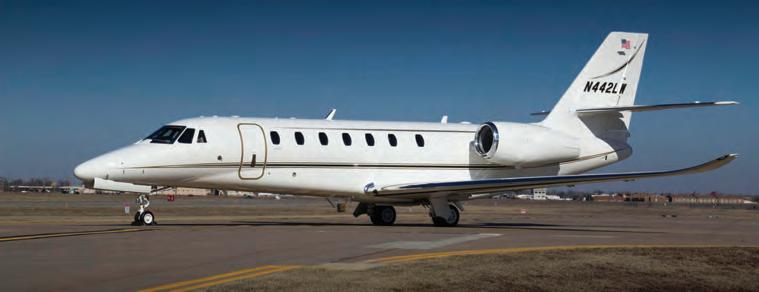

The three aircraft on display—a 2018 Beechcraft King Air 250, 2014 Cessna Citation Sovereign+, and 2019 Embraer Phenom 300E (for charter)—represent the range of light to midsize cabin aircraft the brokerage primarily handles. The good news for buyers of these or other preowned aircraft today: “For the first time in a couple of years, we’re starting to see a little bit of realism in asking prices,” Deaton said, noting a late-summer increase in inven tory that has reduced upward pricing pressure.
“In some cases, we’re seeing price reduc tions in aircraft that were overly valued, and
that’s really refreshing,” she said. But she doesn’t expect that to last.
“We are entering into the fourth quarter,” traditionally the most active quarter for business aircraft transaction activity, Deaton noted. “I think we’re going to clear out the increased inventory we’ve seen, and that’s going to keep values relatively high for the balance of the year.”
She advises shoppers to stay calm and realistic. “I don’t think we’re in a market that requires any reactionary behaviors,” Deaton said. “We prefer to keep cool heads as we move into the fourth quarter.”
Coming off a strong 2020, JetAviva set a new record in 2021 with more than 100 transactions. Citation Excels, Pilatus PC-24s, and Phenom 100s lead those sales, according to JetAviva.
“This year, we’re on pace to meet or exceed the number of transactions,” Deaton said. Con comitant with rising valuations, average revenue per transaction has risen “slightly,” she added.
Adding to the bottom line: though JetAviva doesn’t typically inventory or buy aircraft to hold for later sale, “this year presented some opportunities that were worth taking a risk on, and it paid off,” she said. “That’s had a posi tive impact on our revenues as well.”
New-to-ownership buyers represented 30 percent of customers last year, but yearto-date only about 10 percent are first-time buyers, she noted, “a more normalized, sort of pre-Covid number.”
Founded in 2006, JetAviva has specialized in the light and owner-flown end of the tur bine business aircraft market, but with 40 percent of its business transacted with repeat customers, that niche has evolved along with clients’ needs.
“We really do enjoy serving our owner-flown clientele,” Deaton said. “We have a tremen dous amount of experience in that market segment that enables us to really serve them. [But] our clients have continued to grow into the larger categories of aircraft, so about 20 to 25 percent of our business every year is in midsize or larger category aircraft.”
JetAviva this year joined the International Aircraft Dealers Association (IADA), whose benefits, she said, include giving the com pany an opportunity to join group efforts to tackle industry problems. “Right now, we are working directly with the FAA to improve accessibility to [designated engineering rep resentatives], a very real-time challenge that we’re facing in the industry,” said Deaton.
Meanwhile, in January the company will launch “a very exciting brand-refresh project” that’s been in the works for a year.
“It will be a different look and feel that will affect our digital and print, and our physi cal marketing at events,” said Deaton. She was selected as one of NBAA’s 2022 “Top 40 under 40” leaders in business aviation and was named CEO of the company in January.
“When you have the opportunity to take on a leadership role at a well-established and successful organization like JetAviva, I don’t think any broad-based change is necessary,” she said. Going forward, Deaton added, the company will focus on “preserving the great things about our brand” while cultivating “the culture of operational excellence that enables us to embrace opportunities.”
Deaton succeeds Tim White, who led the aircraft brokerage firm since 2016. White is taking the role of vice-chairman, working alongside company founder and executive chairman Cyrus Sigari. z




 Report by Curt Epstein, charts and data by Dave Leach
Report by Curt Epstein, charts and data by Dave Leach
With the world still navigating its way out of the pandemic, the aviation industry has seen many changes over the past year. While airline traf fic has yet to return to pre-Covid levels, business aviation has not only rebounded but has set new records as first-time customers have sought to avoid crowded airport terminals.
Against this backdrop AIN again tasked its readers to rate FBOs they frequented over the year in five categories: line service, passenger amenities, pilot amenities, facilities, and CSRs. While some FBOs may shine in one or two categories, to land at the top of the survey ratings a location must exhibit all-around excellence. We present to you this year’s top 5 percent.z
JET AVIATION KPBI PALM BEACH INTERNATIONAL 4.72-0.01
WILSON AIR CENTERKMEM
INTERNATIONAL 4.72-0.01
SHELTAIR KBJC ROCKY MOUNTAIN METROPOLITAN 4.71N/A
WESTERN AIRCRAFTKBOI
SHELTAIR KFLL
OAKLAND COUNTY INTERNATIONAL AIRPORT (KPTK), PONTIAC, MICHIGAN
Repeating its position at the top of the ratings this year is Pentastar Aviation. The FBO, the standout in a flock of five service providers at Detroit-area Oakland County International Airport, earned the same total as last year and garnered its highest score this year (4.84) in the CSR category. Founded in 1964, the company was originally the flight department for the Chrysler Motor Company but began to expand its services to other aircraft operators. It has since developed into the epitome of a full-service FBO offering not just the
FARGO
GLOBAL
BOISE AIR TERMINAL/GOWEN FIELD 4.710.01
FORT LAUDERDALE/HOLLYWOOD
FIELD4.680.01

GE’s OnPoint service program provides comprehensive business jet coverage with 24/7 rapid maintenance response, exclusive diagnostics, design expertise and OEM parts. We’re here to keep you fying — anytime, anywhere.

traditional ground handling and fueling, but aircraft maintenance, avionics and cabin interior shops, aircraft management and charter, and even its own in-house catering department/café Fivestar Gourmet.
Occupying nearly 22 acres at PTK, Pen tastar has ten acres of reinforced ramp, and approximately 130,000 sq ft of hangar space which is home to 21 aircraft ranging from a Gulfstream G100 to a BBJ. Its main 5,000-sq-ft terminal which is staffed and operational 24/7, has passenger lounges, multimedia-equipped conference rooms, concierge, and the Fivestar Café. The 10,000-sq-ft two-story satellite Stargate terminal is specially equipped to handle large charter flights such as sports teams, with the country’s only privately-operated jet bridge and baggage carousel, along with a departure lounge.
Sheltair acquired the Tampa International Jet Center, a perennial top scorer in the AIN FBO Survey, in 2016 and the location has not missed a beat since, claiming a share of the top score this year and ranking among the highest in the Line Service (4.79), Passenger Amenities (4.76), Pilot Amenities (4.72), and Facilities (4.78) cat egories. Proving its all-around excellence, it was one of the two FBOs to top 4.7 or higher in every category. The FBO is known for its 13,000-sq-ft aircraft arrival and departure canopy, which can handle anything up to a Bombardier Global 7500 and shelters passengers from Southern Florida’s alternating intense sunshine or rain showers. That adjoins the location’s 11,000-sq-ft terminal with its airy two-story atrium and inlaid marble floor map. A porte cochere welcomes vehicles on the landside.

The company strives to keep the building in pristine condition and it recently remodeled its cantina area along with the two conference
rooms. A major modernization project is approved and scheduled to begin by the end of the year.
The IS-BAH Stage 2-registered facility is open 24/7 with U.S. Customs located adja cent to the terminal. Its current 150,000 sq ft of hangar space, is home to 29 business jets, six turboprops, and four helicopters. A new hangar complex under development will add another 100,000 sq ft of aircraft storage and office space.
FORT WORTH MEACHAM INTERNATIONAL AIRPORT (KFTW), FORT WORTH, TEXAS
American Aero FTW is celebrating the fifth anniversary of its permanent facility this year and it has ranked at or near the top in AIN’s annual FBO survey every year since it opened. It is only the second location this year to gar ner 4.7 or higher scores in each of the five survey categories, ranking among the top 10 in Passenger Amenities (4.71), Pilot Amenities (4.71), and CSRs (4.84).
The 8,600-sq-ft terminal was designed with the utmost customer comfort in mind, with details such as self-tinting glass windows, white noise speakers embedded in the lobby
more than a quarter-million sq ft of hangars, which can accommodate the latest ultralong-range business jets. The FBO, which is staffed daily from 6 a.m. until 10 p.m. with after-hours callout available, is home to 50 turbine-powered aircraft. Over the past year, the location added a pair of 20,000-gallon jet-A storage tanks to its fuel farm, bringing the Avfuel-branded location’s total capacity to 115,000 gallons.
From its founding in 1979, Banyan Air Service has grown until it now provides an entire pri vate aviation ecosystem on 120 acres at Fort Lauderdale Executive Airport. The location

walls along with sound dampening materi als to provide a tranquil environment, and a fully-soundproofed snooze room, along with other features such as a crew lounge with shower facilities, a crew dining room with china service, one of the industry’s best-pro visioned refreshment bars, 80 sheltered parking spaces, 25-seat A/V-equipped conference room, a high-speed dishwasher for aircraft service items, and a private VIP lounge with ensuite bathroom and direct ramp access.
The 34-acre complex includes 11 acres of ramp, 45,000 sq ft of o ffi ce space, and
is home to 185 private jets and turboprops, a number that it says is “growing by the day.” To shelter them, the IS-BAH Stage 2-registered facility, which is open 24/7, manages more than 1 million sq ft of hangar and office space, includ ing the recent Sheltair-built Northside complex, which added 180,000 sq ft of fully-occupied hangars and a 9,500-sq-ft satellite terminal.
The 14,000-sq-ft main terminal, which recently underwent an interior refresh, features a two-story, Key West-themed atrium, including a waterfall, 800-gallon saltwater aquarium, and 30-foot-high palm trees; a café with rampside views; three pilot lounges; snooze rooms; crew shower facilities; a trio of conference rooms; business center; crew courtesy and onsite rental cars; and one of the largest pilot shops in the world, all of which combined to give the FBO its top 10 scores in the Facilities (4.80) and Pilot Amenities (4.71) categories.
In addition, the company provides airframe and turbine engine maintenance, an avionics shop, a well-stocked aircraft parts department,
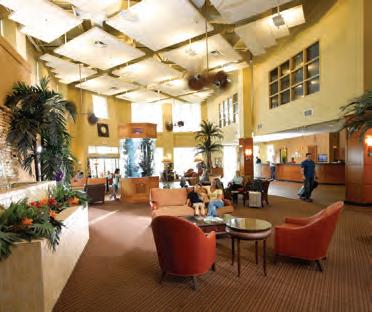
aircraft sales, and aircraft and auto detailing. As a designated Bahamas Gateway FBO there are plans to eventually have a Bahamian Customs official serving onsite to issue preclearance for operators, and the Banyan staff stands ready to assist with documentation for travel through out the Caribbean. U.S. Customs and Immi gration service is available daily from 8 a.m. until midnight.

Representing privately-owned Austin Executive Airport is its FBO Henriksen Jet Center, which ranked in the top 5 percent in AIN’s FBO sur vey for the fifth straight year, a span that has seen the facility earn the top score in the Pas senger Amenities category (4.82) as well. The terminal, which just celebrated its tenth anni versary, suffered flooding last February during the deep freeze that plagued the entire state, with a sprinkler line leak pumping thousands of gallons of water into the 21,500-sq- ft two-story facility. Undeterred, its staff bounced back with a major renovation program that concluded in October, restoring the facility to its previ ous glory, keeping its AIN FBO Survey streak

intact, and ensuring its top score (4.82) in the Facilities category as well. Among its popular features is a 15,000-sq-ft arrivals canopy large enough to accommodate a BBJ-sized aircraft, which helps keep them cool on days when the scorching Texas sun can heat the tarmac hot enough to cook eggs. The glass-enclosed, dou ble-height atrium features a fully-restored 1914 Indian motorcycle and an Olympus engine from a former Concorde airliner on display.
A theater room with stadium seating, pilot lounge, shower facilities, 12-seat a/v-equipped conference room, and a pair of massage chair-equipped relaxation rooms round out the amenities.
Jet Aviation has operated its FBO at Palm Beach International Airport for nearly four decades, and in terms of the AIN FBO Sur vey, it remains the most decorated among the company’s 11 locations in the Americas, a reg ular fixture among the top rungs. The facility, which operates 24/7, ranked among the top 10 in the Pilot Amenities category (4.69), and it earned its highest score for its CSRs (4.79).
The facility occupies the same two-story 18,000-sq-ft terminal since it opened, but it has been kept up to date with regular upgrades and renovations, the latest of which is sched uled for 2023 with design plans currently underway. It features an 8,000-sq-ft pilot suite consisting of a snooze room, lounge, showers, coffee area, and flight planning area, which opens onto the main lobby.

snooze room, business center, conference rooms, flight planning area, and refreshment bar stocked with local favorite Blue Bell ice cream. With Memphis known for its legendary barbeque, those wishing to take a taste of it home can purchase frozen racks of ribs at the FBO, which will be loaded onto their aircraft.
AIRPORT (KBJC), DENVER, COLORADO
Demonstrating its consistency, Western Air craft in Idaho earned its second straight position in the top 5 percent of our survey, this year by improving its score and landing in the top 10 in the Passenger Amenities (4.78, finishing second in that category for the sec ond year in a row), Pilot Amenities (4.72), and Facilities (4.75) categories. A member of the Greenwich AeroGroup, the company is celebrating its 65th anniversary this year. It occupies a 15-acre leasehold at KBOI with a 3,800-sq-ft terminal offering a pilot lounge with a pair of recently-added snooze rooms and shower facilities, eight-seat A/V-equipped conference room, flight planning area, passenger lounge with refreshment bar, galley, courtesy cars and shuttles, plane-side vehicle valet, and concierge.
Wilson Air Center, a small FBO chain with four locations in Tennessee, Texas, and North Carolina, knows quite a bit about hospitality with the late patriarch Kemmons Wilson being the founder of the Holiday Inn hotel chain. The company’s flagship location once again earned a spot in the top 5 percent of AIN’s annual FBO survey, landing in the top 10 in the Passenger Amenities category (4.72) and tallying its highest individual score in the CSR category (4.79). The latter can be attributed to the company’s policy of never saying “no” to a patron. Hailing back to its hotel roots, Wilson was one of the first to institute concierge service to the FBO industry, with a greeter meeting each arriving or departing aircraft
The location, which occupies more than 17 acres at KMEM and is open 24/7, has a 5,700sq-ft terminal that includes a pilot lounge with
Sheltair’s newest FBO and its first location away from the East Coast of the U.S. wasted little time landing in the top 5 percent of FBOs in this year’s survey. The company began operations at Denver’s Rocky Moun tain Metropolitan Airport from a temporary facility in January 2019. The $20 million per manent complex followed in mid-2020 during the height of the pandemic and earned AIN’s inaugural Top Flight Award for best new FBO. The 27-acre leasehold includes a 10,400-sq-ft terminal with a land-side porte-cochere for passenger drop off and pick up, and an aircraft

arrivals canopy that can handle anything up to a Bombardier Global 7500. Its design features pine, stone, and exposed raw steel as well as a radiant-heat floor for customer comfort.

Amenities include two A/V-equipped confer ence rooms, passenger and pilot lounges with fireplaces, snooze rooms, concierge, crew cars, and onsite car rental. Guest passes to a local climbing gym are also available.
Sheltair’s third location to rank among the top 5 percent in this year’s AIN FBO Survey is its flagship location at Florida’s Fort Lauderdale Hollywood International Airport. Established in 1988, it is the CAA-preferred FBO as well the largest of four service providers at KFLL with a more-than 50-acre leasehold. Its 22 hangars encompass more than 320,000 sq ft of space and are home to 85 business jets and 15 turboprops.
The location, which has a staff of 60 and is open 24/7, earned its top score this year in the CSR category (4.75) and ranked among the top 10 in the Pilot Amenities category with its score of 4.68. Its 51,000-sq-ft terminal is slated to undergo lobby renovation this year. It has onsite 24-hour U.S. Customs, pilot lounge and snooze rooms, a deli/café, gym

with locker rooms and showers, duty-free shop, onsite car rental, and crew cars.

The highest rated FBO among the five ser vice providers at Dallas Love Field, familyowned Business Jet Center improved its score enough this year to move back into the top 5 percent. The company, which celebrates its 25th anniversary this year, is known for its unique 33,000-sq-ft, three-story atrium ter minal, which offers three crew lounges, three snooze rooms, private crew shower, game room with golf games, foosball, and pinball, three conference rooms, a large meeting room, three Mercedes-Benz crew cars, and a well-stocked refreshment area with a smart water dispenser that allows users to fully cus tomize their beverage. Canine passengers are welcomed as well with treats and their own


Shaking your hand when you bring your aircraft in.
Focusing on every detail of your work order. Delivering optimal avionics connectivity. Showcasing all your options for interiors. Talking to you right on our shop floor. This is where you’ll find them.
Absolute quality is at the heart of everything they do, and we’re proud to put their nearly 100 years of combined Gulfstream specific experience to work for you.
fire hydrant relief area.
The Paragon FBO Network member is home to a flock of aircraft including 66 jets ranging from a Gulfstream G650 to an Eclipse 500, along with seven turboprops, and to house them it currently has more than 250,000 sq ft of hangar space. Its most recent and largest of the 15 structures opened in 2019, and another 49,000-sq-ft hangar is expected to open in the second quarter.
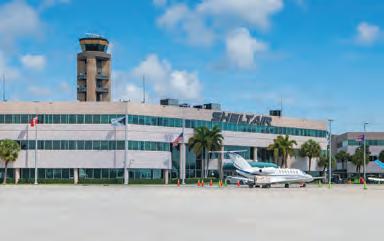
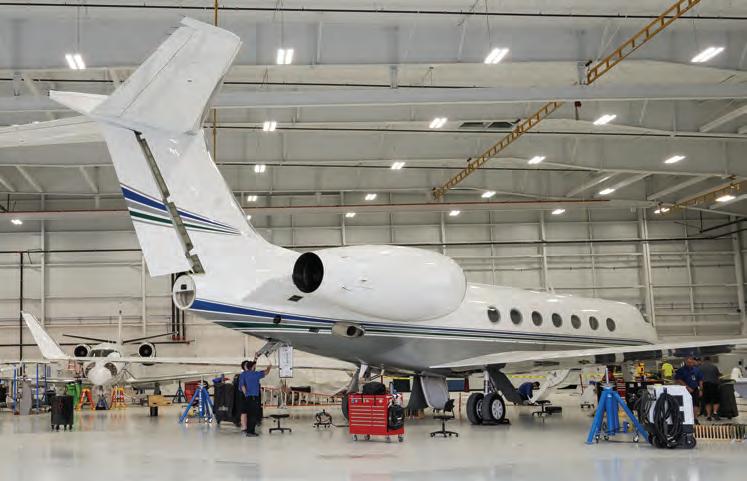
Talk to our team about your Gulfstream aircraft at NBAA, booth 1475.

 Doug Wendt Regional Sales Manager
Brody McKenna Avionics Manager
Jim Fisher Interior Programs Manager
Russell Crouch Service Manager
Doug Wendt Regional Sales Manager
Brody McKenna Avionics Manager
Jim Fisher Interior Programs Manager
Russell Crouch Service Manager
The only independent service provider at New York City business aviation hub Teter boro Airport, Meridian is the only FBO in the Northeastern U.S. to rank in the top 5 percent of this year’s AIN FBO Survey. The family-owned company, which is celebrating its 75th anniversary, has always been known for customer service as evidenced by its top 10 score in the CSR category (4.83).
The location occupies a nearly 18-acre leasehold at TEB, with a three-level, 30,000sq-ft terminal. Among its amenities are a pilot lounge with two snooze rooms, flight planning area, two conference rooms, a gym with locker rooms and showers, an Art Decothemed theater room, business center, and a two-story atrium lobby with a custom hot beverage machine.
area, 50-seat meeting room, crew cars, the Exchange pilot/gift/food shop, and refresh ment bar. The 10-seat conference room just completed a technology update with 75-inch television and upgraded power and data inputs.
HECTOR INTERNATIONAL AIRPORT (KFAR), FARGO, NORTH DAKOTA
Fargo Jet Center has earned its reputation for quick turns as a tech stop for domestic and international flights, but the location, which is home to 23 jets and 22 turboprops, has also made a name for itself for the little things, such as the inviting smell of muffins baked in house every morning, or having a custom er’s car warmed up and waiting on a North Dakota winter day where 10 degrees is con sidered warm.
SUGAR LAND REGIONAL AIRPORT (KSGR), HOUSTON, TEXAS
Continually refuting the notion that airportoperated FBOs can’t be exceptional is Global Select, the lone municipally-owned service provider at Houston-area Sugar Land Regional Airport. The perennially highly-regarded facility for the second year in a row took home the highest score in the Facilities category (4.82), as well as the top ranking in the Pilot Amenities category (4.76). It garnered a top 10 placement under Passenger Amenities (4.72).
Another airport-managed facility to land in the top 5 percent this year is Base Oper ations at Page Field. The current 20,000sq-ft terminal opened in 2011 and ranked among the highest scores this year in the facilities category (4.76). The facility pays homage to the airport’s start as a WW II U.S. Army Air Force facility. A full-scale model of a P-51 Mustang fighter hangs from the ceil ing in the atrium lobby, and display cases packed with memorabilia and period photos line the walls.
Amenities include a pilot lounge with showers, soundproofed quiet room with oversized recliners, a “rec” room with pool table and retro video arcade games, snack lounge with café seating, flight planning
Open 24/7, the lone service provider at Hector International Airport has operated since 1995, and its 15,000-sq-ft terminal offers a comfortable lobby with fireplace, a private crew suite with snooze room, shower facil ities, and refreshments; full concierge; five A/V-equipped conference/training rooms; valet parking; crew cars; and aircraft and auto detailing. A 3,600-sq-ft U.S. Customs facility is located adjacent to the terminal.


The City of Sugar Land has owned and operated the airport since 1990, and in 2010 branded its FBO as Global Select. It has a 20,000-sq-ft terminal with a crew suite that includes three snooze rooms, a relaxation room with a zero-gravity recliner that is in constant demand, kitchen, library, shower and bathrooms, flight planning area, TV room, and theater room with an 80-inch screen and dedicated sound system featuring movie concession snacks, as well as a 3,000-sq-ft passenger lobby with gift shop, walls decorated with available artwork from local artists, and a café.

HOUSTON, TEXAS.
Henriksen Jet Center’s original location at Houston Executive Airport once again joins its younger sibling at KEDC in the top 5 percent of this year’s AIN FBO Survey. Both KEDC and KTME are privately owned and built by Ron Henriksen. KTME opened in 2006 and its 22,000-sq-ft terminal arrived in 2013. It ranked second this year in the Pilot Ameni ties category (4.74, not surprisingly tallying the same score as its sibling, which it closely resembles), as well as landing in the top 10 in the Facilities category (4.76).

It includes 8,000 sq ft of tenant office space, as well as a two-story lobby with an authentic Ferrari 333SP race car on display, floor-to-ceiling windows overlooking the ramp, crew suite with theater room, shower facilities, a pair of snooze/ quiet rooms, kitchenette and dining area, flight planning room, 10-seat A/V-equipped confer ence room, refreshment bar, and concierge.






Continuing Sheltair’s strong showing in the top tier of this year’s FBO survey is its facil ity at Jacksonville International Airport, the Florida-based chain’s fourth location to place in the top 5 percent. The FBO, one of two service providers at KJAX, has been in operation

for nearly two decades and is open every day from 5 a.m. until 11 p.m. with after-hours call out available.
The FBO’s 26,000-sq-ft, two-story terminal offers a variety of top-tier amenities including a gym with locker rooms and showers, pilot lounge with snooze rooms, refreshment bar, concierge, a pair of A/V-equipped conference rooms seating 10 and six respectively, crew cars, shuttle service, and onsite car rental. Last year Sheltair added 1,750 sq ft of office space on the second floor and a similar-sized space is scheduled for development this year.

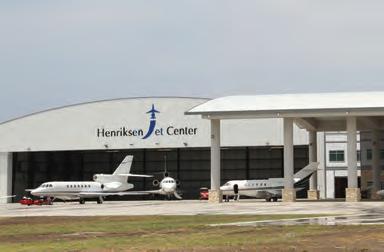
The location has achieved IS-BAH Stage 2 registration and also serves as an official Baha mas gateway.
The HALOTM Safety System with Garmin® Autoland—the most groundbreaking advancement in recent general aviation history—does everything you would do when you can’t. After alerting ATC, checking fuel levels and weather, it safely lands the aircraft. In short, it’s as if the controls were still in your hands. See how your highest standards come standard at piper.com/HALO.
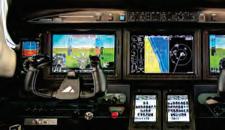
To learn more about the HALOTM Safety System with Garmin® Autoland, visit us at the Orlando Executive Airport Booth #AD_409, or inside the Orange County Convention Center at Booth #4886.

Aviation insurance solutions provider Starr Insurance (Booth 3014) has developed a pro gram to maximize a business aviation company’s savings and operational safety. The Starr Safety Partnership program, announced today, provides access to a portfolio of premium service providers at a significant discount. The program focuses on the entire life cycle of aircraft ownership, with an emphasis on safety and cost-efficient operations.
“The Starr Safety Partnership provides Starr clients access to preferred pricing with many of the best-in-class aviation service providers,” said Starr assistant v-p, director of safety and loss control Andrew Madison. “The partnership includes services focused on the entire aircraft ownership life cycle that increase operational savings and promote safety, safety management system facilitation, and training. It also gives the aircraft owner an extra measure of safety assur ance, all to help our clients enhance the safety of their operations and reduce losses.”
The Starr Safety Partnership includes twelve service providers that “are well known in the industry for providing top-notch solu tions and customer service,” according to Madison. “This was confirmed by our firsthand experience with some of the service providers and client feedback.”
One featured safety partner, Aviation
Performance Solutions (APS, Booth 2081) is dedicated to training pilots to overcome the leading cause of aviation fatalities—loss of control in-flight (LOC-I) accidents. APS offers a proven upset prevention and recovery training (UPRT) system that uses academics, on-aircraft flight training, and advanced sim ulators to curb the threat of LOC-I, all taught by a group of well-qualified instructors.
“APS has an industry-leading reputation for excellence and innovation in the general aviation upset recovery training space, both in the classroom and in practice, applying the class room learning with customers in their fleet of aircraft in Arizona [and around the world],” said Starr senior v-p and chief underwriting officer Kyle Sparks.
APS’s stated mission is to “crush the LOC-I threat globally by partnering with ‘safety champions’ to accelerate the adoption of life-saving APS upset training,” APS CEO Paul “BJ,” Ransbury said. “Starr Insurance’s Safety Partnership Program is an extraordi nary opportunity for Aviation Performance Solutions to be on-mission by partnering with Starr Aviation and its noble safety program.
“We help pilots bring everyone home safely, and Starr’s solutions support aviation safety at every stage of aircraft ownership. It allows us to broaden our reach and continue to be

on the forefront of saving lives.”
Offering unique and innovative solutions to its UPRT program makes APS a top-tier training provider for a diverse set of opera tors. “APS is unmatched in its total integrated solution to UPRT. We have dedicated our core services for over 25 years to overcome the loss of control inflight: the number one fatal threat to every pilot on every flight,” Ransbury said
He added, “Our solution to LOC-I has been recognized internationally for its proven, comprehensive multi-day integrated program that includes academic, on-aircraft (both piston and jet), advanced simulator, and type-specific virtual reality [training]. APS is the only organization that has the most com prehensive solution in the industry and will contribute directly to the operational safety of Starr’s vast and differentiated customer base.”
The LOC-I threat is real and almost always fatal, APS executive v-p of standards and compliance Clarke McNeace said. “LOC-I is unequivocally every pilot’s number-one threat every time they are airborne. ICAO, FAA, EASA, and numerous other industry stakeholders have all acknowledged this threat and have required or recommended integrated on-aircraft, simula tor, and academic UPRT to address this unique and critical skill set for every pilot.”
APS offers a comprehensive and immersive UPRT experience that is adaptable to Starr’s diverse client base of fixed-wing aircraft oper ators ranging from single-pilot piston to multicrewed, high-performance business jets. “APS provides customized fixed-wing UPRT solu tions for each of the industry sectors through its ‘Every Pilot In Control Solution Standard,’” McNeace said. “It brings transformative, life-saving training tailored to each pilot’s oper ating environment and equipment. Our UPRT programs are designed with three main factors in mind: first, how the pilot operates—single pilot or crewed—and mission type; secondly, where they operate—VFR/IFR, low altitude, high altitude, etcetera; and the specific type and class of airplane they operate to minimize the gaps in their risk management of LOC-I.”
According to Ransbury, “For executive, corpo rate, business aviation, and on-demand oper ators [Part 135/125]—the bizav operator—the biggest challenge faced is being well behind UPRT solutions being implemented by Part 121 air carriers through the implementation of FAR 121.423 ‘Pilots—Extended Envelope Training.’”
He added, “While Part 121 operators are implementing this limited simulator-only solu tion, it is considerably more than what is being implemented by bizav in general. The good news is that this partnership with Starr and APS will allow far more effective and robust UPRT solutions through minor, and in some cases cost-neutral, investments in progres sive, proven-effective, and fully comprehensive UPRT and aviation safety.”

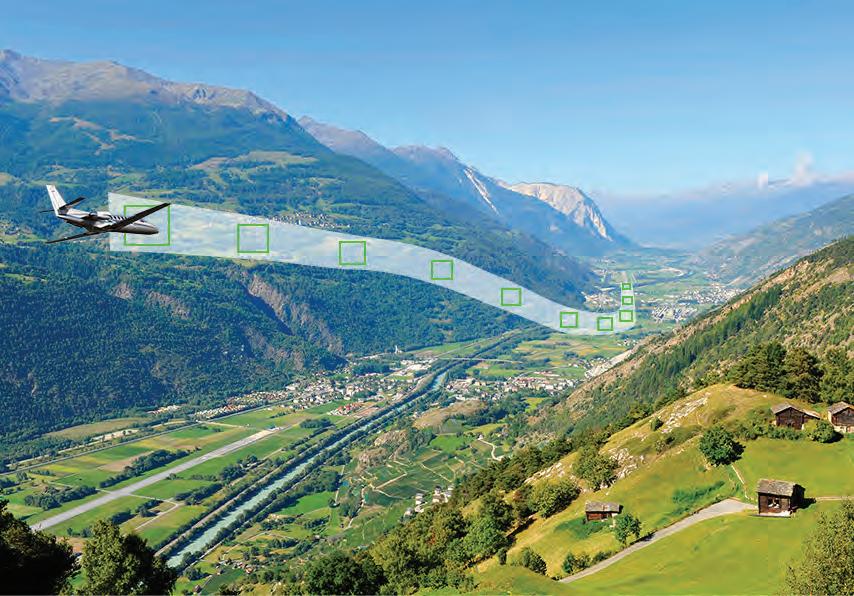
Reducing risk in aviation is a priority for insurers and operators alike. The Starr Safety Partnership Program provides a multitude of options for operators to reduce risk.

Madison said “the program expands on their experiences and pilot skills through APS, Air Care International, and Advanced Air Crew Academy. Another benefit is in enhancing or developing our clients’ safety management system with the help of Argus, AviationManu als, or Polaris Aero to effectively manage safety and reduce losses.” Beyond safety, Madison added, “The program will also reduce operat ing costs; as an example, JSSI serves to ensure standardized maintenance and reduce air craft downtime.”
The Safety Partnership Program is available

Aviation Performance Solutions aims to help Starr Insurance clients reduce the risk of loss of control.
to any Starr client operating under Part 91 or Part 135. Starr’s Sparks said that “a generally accepted principle is that investments in safety over the long-term lead to safer and more profitable organizations with fewer accidents, a happier workforce, and less downtime for company resources.”
He added, “Some of the Starr Safety Part ners, such as JSSI, are able to deliver cost savings and expanded coverage to Starr cus tomers due to their industry-leading capa bilities. There is no premium discount for using the Starr Safety Partnership Program; the program is a Starr initiative to help the insured and the industry foster a safer envi ronment for operating aircraft.” z
Demand for lift has sparked a resurgence in refurbishment activity at Flying Colours (Booth 4657), including conversions of the Bombardier CRJ-200 regional jet. That’s a market the Canadian Bombardier MRO spe cialist pioneered more than a decade ago. The CRJ-200 program is now owned and supported by Mitsubishi Heavy Industries.
“The demand for charter and for private flying that has risen out of Covid has created a niche for the conversions, and you can buy [CRJ-200s] cost-effectively from airlines no longer using them,” Flying Colours execu tive v-p Eric Gillespie told AIN on the eve of NBAA-BACE. “It’s an excellent choice for owners seeking a fully customized aircraft, and we have seen more inquiries in the last six months than in the last few years.”
Flying Colours is showcasing images and details of recently completed refurbishment and conversion projects this week at the show, a trend further pushed by the dearth of qual ity large-cabin aircraft available for sale and growing OEM backlogs.
“In a market where good aircraft are hard to find, and new-production aircraft waiting times are long, conversions provide an excel lent solution for operators who want to quickly access aircraft,” said Gillespie. “You can get a used airplane and refurbish it to your own spec ifications for a lot less cost than buying new.”
The basic ExecLiner conversion of the CRJ200, introduced in 2008, features a 14-seat interior comparable to that of a large-cabin jet. “You essentially get the same-size cabin as a Bombardier Global 6000,” said Gillespie, with the range and performance of a super-midsize jet. Optional auxiliary tanks can boost the range by more than 50 percent, to 3,100 nm.

The interior outfitting and layout can be adapted to the needs of individual customers. Flying Colours has performed more than 30 of them “in every possible configuration,” Gillespie said. That includes VIP; corporate shuttle; medevac; VIP/medevac change-out; special mission; and more than a dozen additional VVIP ExecLiner completions on green CRJ200 airframes.
Most shuttle configurations opt for 16 to 18 business jet seats. But a conversion now under way is being outfitted to cater to sports teams, touring music groups, and corporate custom ers and features a 29-passenger split layout: a galley and six business jet seats and a divan in the front of the cabin and 20 airline-style seats behind. Side-ledge storage provides room for laptops, purses, and briefcases, with stowage for small suitcases and carry-ons fore and aft. Onboard high-speed Wi-Fi is provided by
Gillespie cited other custom touches on recent projects: a countertop and sink of satin nickel-plated stainless steel. A thin and chal lenging material to work with, the metal was molded into a seamless surface for a largecabin galley with matching countertops in the forward and aft lavatories.
For an owner who uses custom-designed curved water bottles for water from his own spring, Flying Colours created custom drink holder inserts, made of quarter-inch thick Lexan, cradling the bottles perfectly in the cooler drawer. The inserts can be removed to accommodate regular-sized bottles.
“We can do it all under one roof,” said Gilles pie, noting the company has the engineering, certification, interiors craftspeople, techni cians, and other skills and capabilities required
Gogo Avance L5 connectivity, though Ka- and Ku-band satcom options are also available.
Demand is also strong for interior upgrades on legacy Bombardier Challenger 850s and Globals, and the company has extensive refurbishment and completions experience with both models. In fact, some recent projects have involved airframes the company per formed initial completion work on more than a decade ago, Gillespie said.
The recent refurbishment of a 20-year-old Challenger 850 included an avionics upgrade and exterior paint, in addition to a complete interior overhaul. Tasked with creating “a modern yet elegant interior with a genuinely unique style” for use in the charter market, the cabin’s 12 seats became the focal point of a dia mond-pattern-themed interior, with seatbacks hand-stitched in quilted diamond patterns, com plemented by custom-designed carpets. The new livery was applied at the company’s paint facility at its Peterborough, Ontario headquarters.
in-house, providing more control over proj ect outcomes and delivery schedules. Flying Colours also has MRO facilities in St. Louis.
Gillespie acknowledged the choices a cus tomer faces when planning a refurbishment or conversion can seem overwhelming. But he advises anyone taking on the challenge to start by answering a few basic questions: “What’s your mission? What’s your end goal? Are you going to charter it out? In which case you want to look for more durable fabrics and materials, or are you just going to use it for yourself and want to make sure it’s 100 percent customized to what you and your family want?
Going forward, additional commercial platforms may be targeted for makeovers. “We’ve seen interest in Embraer conversions on the ERJ-135 and -145, and we’ve talked to customers about the E190.” Though discussions are preliminary, “the interest is there,” Gillespie said. “That’s from all over the world, not just North America.” z
Tamarack Aerospace will offer full carbon sequestration for its customers’ carbon footprints under a memorandum of under standing (MoU) it signed with Yasava Solutions and its sister company Oxï-Zen.
The agreement covers OxïZen’s carbon-balancing services, which instead of offsetting carbon emissions use carbon sequestration or absorption to match the carbon footprint of the emitter (aircraft opera tors) with the same amount of sequestration. The emitter can also select criteria for the type
of converter, which “can include geolocation, type of carbon sink, and the convertor’s program to protect and enhance the car bon sink environment, [as well as] development of infrastruc ture in accordance with the UN’s Sustainable Development Goals,” according to Tamarack. Data integrity is assured using blockchain technology.
Costs of Oxï-Zen carbon bal ancing depend on factors such as aircraft type, fuel usage, and carbon and fuel prices when the emitter signs up for the program. Tamarack views the collaboration with Oxï-Zen as helping potential customers elect to modify their

aircraft with Tamarack’s ecoSmartwing load-alleviating active winglet technology.
“The aviation industry will not reach its goal of a net-zero car bon neutrality without meaning ful collaborations like the new

harmony between Tamarack and Oxï-Zen,” said Tamarack founder and CEO Nick Guida. “Our new MoU with Oxï-Zen is another example of how all of aviation can work together for a cleaner planet.” z

After three years of not exhibiting at NBAABACE due to the Covid pandemic, paint manufacturer Sherwin-Williams Aerospace Coatings (Booth 3169) is back. “We’re excited to get in front of our key customers,” said Julie Voisin, global marketing manager.

In addition to showing attendees how they can play with color combinations on the Sherwin-Williams color visualizer, the com pany is highlighting its JetPen Touchup paint pen at its booth.
While future paint job customers can test any of 333 Sherwin-Williams colors on the visualizer (also available online), there are some trends that rise above the normal ebb and flow of color choices, Voisin told AIN, among them semi-gloss or matte finishes in grays and blacks. A recent example is the matte-gray Falcon 900 (see top photo), painted by West Star Aviation, with eye-popping mango orange accents and striping.
“[The trend] is a little all over the place,” Voisin said. “It’s splitting down the middle. A lot of people like the regal look of white with accent stripes. The other 50 percent are going a little more colorful, and we’re seeing more effect finishes such as metallics and micas, a lot more gray shades instead of white overall.”
Some of the more unique paint jobs, she added, include camouflage patterns and aircraft body colors in flashy shades such as bright green. “Some people are trying to not be noticed and some are [saying], ‘Hey, if I’m going to have a business jet or gen eral aviation airplane, I want to be recog nized and noticed and take risks with color and design.’”
There is nothing new in the paint world as far as maintenance goes, except there are mainte nance considerations for semi-gloss and matte finishes. Glossy paint is easier to touch up and match with careful buffing. But the semi-gloss and matte paints need extra work for scratch
repairs because touchups will be more notice able and repainting of a damaged area may be needed, according to Voisin.
That’s not to say that semi-gloss and matte paints aren’t durable, however. “We’ve been doing semi-gloss and matte with the military for years,” she said, “although the standards for appearance for military compared to business aircraft are very different.” In any case, longevity with these types of paint isn’t a concern.

Maintaining a paint job in peak condition isn’t hard, according to Voisin. “Our numberone tip for keeping it looking good is don’t put too much product on it. Waxes can end up doing more damage to the coating over time.” The recommended treatment is simply washing with Dawn dish soap and water. “The paint is designed to handle the conditions it’s being put under,” she said.
No matter the kind of paint, prospective paint customers can try out the SherwinWilliams color palette on six different air frame types in the visualizer, including a helicopter. There are two preloaded designs to get started, provided by paint design house Scheme Designers (Booth 1360).
“The purpose is so you can play with color and see what combinations you like,” Voisin said. Users can not only select the body and accent colors but also spin the model air craft around to view the paint scheme from any direction.
“Then you can take it to your designer for your specific model and your taste,” she said. The chosen design can also be shared on social media. “It’s a fun way to experience color and get your initial thoughts working with our palette,” Voisin added.
“We’ve had a lot of positive reaction from the design community,” said SherwinWilliams spokesman Chris Lynch. “We’re not taking their jobs away, and it gives the designer a much closer heads-up and saves time and money.”
Touching up paint is easy with the JetPen, which is available in all the Sherwin-Williams colors.
The JetPen is not just a tiny container of paint but is a multi-component touchup tool. The paint and the hardener capsule are separate, and when it’s time for a touchup, bending the pen breaks the hardener cap sule so it can mix with the paint. The pen holds 10 cc of paint and includes a chisel tip and brush tip. Paints are available in the pen form as primers and Jet Glo Express topcoat and JetFlex cabin coatings. NBAABACE visitors can try out the JetPen at the Sherwin-Williams booth. z
 by Jerry Siebenmark
by Jerry Siebenmark
Bluetail has completed the development of Mach Conformity, a software module that the Phoenix-based aircraft digital records provider (Booth 2421) said will reduce the time it takes to perform conformity inspections by 50 percent.

The recent growth of the Part 135 ondemand charter market has pressured oper ators to add aircraft onto their certificates faster and more efficiently, explained Blue tail chief operating officer Stuart Illian. “Just doing all the paper records search and conformity steps required by the FAA can add weeks to the process and cost the operator tens of thousands in lost revenue.”
Purchased as a software subscription, the module provides a “conformity binder




builder” to upload documents for the appli cable FAA Flight Standards District Office (FSDO) and digitally “paper-clip” related documents into single units of work, such as
Form 337s with supporting 8130-3 forms. The module also allows users to upload airworthiness directives (ADs) and Chapter 4 and 5 requirements and link supporting documents to the appropriate AD and OEM maintenance program requirements.
A color-coded task manager offers tracking of the status of each binder chapter. The final conformity binder can be saved and its doc uments exported into a standard format for FSDO review.
Bluetail v-p of applications and delivery Greg Baynham said Mach Conformity was developed with the assistance of Part 135 operators and aircraft management compa nies, including Solairus Aviation, Wheels Up, Jet It, Wing Aviation, and Mach Point Aviation.




Bluetail’s Mach Conformity module provides a “conformity binder builder” to help with submitting documents to FAA inspectors.
“These leading operators and management companies were able to confirm that our new Mach Conformity module would help reduce their conformity processes by up to five days,” Baynham explained. “According to the data supplied by the various participants, that time savings alone would translate to tens of thousands of dollars in added revenue per each newly-conformed aircraft.” z
Air Culinaire’s new flagship facility near New Jersey’s Teterboro Airport occupies a reno vated 17,000-sq-ft former warehouse. It represents an 11,000-sq-ft upgrade over the company’s previous facility in the area.
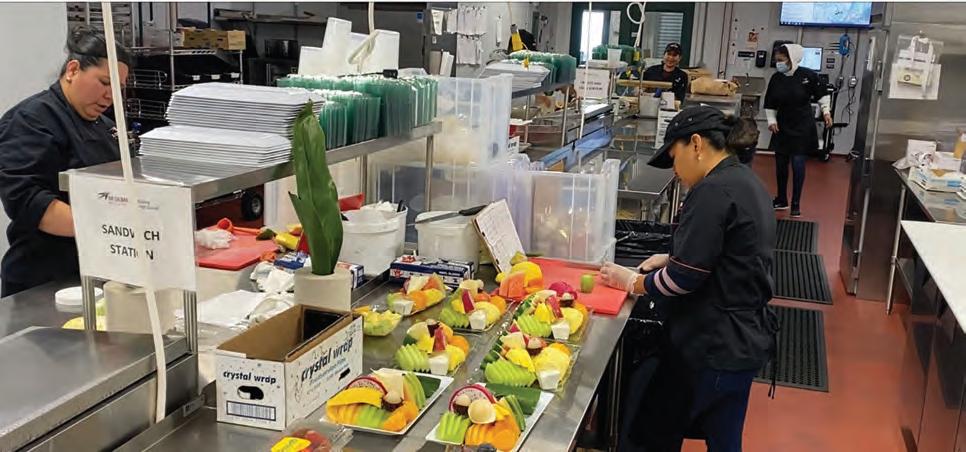 by Curt Epstein
by Curt Epstein
It’s been a busy past few years for Air Culi naire. While the world has grappled with the Covid pandemic, the Universal Weather and Aviation subsidiary, which operates 23 kitchens in the U.S. and Europe, has been expanding many of its facilities in the face of increased activity.
“Our business in 2021 and 2022 increased by 30 percent over 2019,” said Paul Schweitzer, the company’s senior v-p for global sales and marketing. “Our demand mirrors the [private] jet demand, which has been astronomical. We probably have had the highest volume of demand that we’ve ever had for the longest period of time.”
While most of the upgrades were in the planning phase before the start of the pan demic, the timing was perfect as the enhanced locations were able to better meet the needs of the subsequent surge in private aviation.
Last year, the company more than doubled the size of its Seattle location when it moved from a facility at the Modern Aviation FBO at Boeing Field/King County International Air port (KBFI) into a 4,300-sq-ft facility midway between KBFI and Seattle-Tacoma Interna tional Airport. In Chicago, it relocated from a
2,700-sq-ft facility to one within two miles of Chicago O’Hare International Airport, result ing in a 4,800-sq-ft increase, while in Denver and Washington, D.C., renovations of Air Culi naire’s existing kitchens increased their size by 900 and 500 sq ft, respectively.
Among the recently completed expansions, the most strategic was the relocation of its Teterboro, New Jersey location in May. The flagship of the company’s service kitchen network, it moved from South Hackensack to within three blocks of bustling corporate business aviation hub Teterboro Airport (KTEB). An existing warehouse was entirely gutted and repurposed, giving the staff 17,000 sq ft of space.
According to Erick Arce, the facility’s senior general manager, the previous facility could fit in the loading dock at the new building. “One of the biggest improvements is the fact that we were able to create departments for each individual section of the kitchen that we needed to have a department for,” said Arce during a recent visit by AIN. “We have our hot kitchen, we have the expediting station, we also have the cold side of the line station, storage, all of the things that we needed, we were able to fill in immediately.”
Aside from the spacious entry
lobby—which includes several offices, a reception area, and a conference room—all other areas in the facility were built with insulated panels that can support refriger ation. “What that means is any room you will see, all we have to do is slap a compres sor unit in it and change the door so that it seals and it now is a refrigerator,” said Arce. “The idea is that at some point in the future, we can make the entire facility refrigerated depending on business need.”
The KTEB facility is also the first in the company network to have all of its refriger ators monitored through online sensors. Any deviation in temperature immediately results in warning notifications sent to staff members.
Its KTEB location services 14 area airports, including Newark, Morristown, Essex County, LaGuardia, John F. Kennedy International, Republic, Long Island MacArthur, and all the way out to Westhampton Beach on the Eastern end of Long Island. While Teterboro, Newark, and Morristown see continual cater ing deliveries throughout the day, a daily run to New York and the Long Island airports leaves around 4 a.m. to cater to the early morning departing flights. That ride, in one of the provider’s refrigerated vans, can take up

 by Matt Thurber
by Matt Thurber
Honeywell has received its first aftermar ket supplemental type certificate (STC) for installation of its Aspire 400 Inmarsat L-band SwiftBroadband satcom, in this case
in a Bombardier Global Express. Further approvals by Transport Canada and EASA are expected in the coming months, according to Honeywell.
The Aspire 400 has the advantage of providing SwiftBroadband safety-service
communications for secure satellite commu nication between pilots and air traffic con trollers, as well as meeting FANS needs. The system is more compact and draws less power than high-speed broadband satcoms without safety service capability. Segregated channels are available for secure communications, leaving bandwidth available for non-safety voice and data service for passengers.
With a high-gain antenna, the Aspire 400 provides speeds up to 432 Kbps, but Honey well’s high-data-rate software boosts that up to 650 Kbps. Products that can be used for com munications with the Aspire 400 include elec tronic flight bags, telemedicine, and standard IT applications. It can also facilitate offloading of aircraft health and performance information.
“The approval of this STC is a significant achievement for Honeywell and Bombardier Global Express operators and owners,” said Mark Goodman, the senior director of cock pit communications at Honeywell Aerospace. “Aspire 400 provides pilots with a highly reli able and secure link to support enhanced cockpit applications to drive operational efficiency.” z
“It’s
to an hour and 45 minutes to hit all the stops along the way.
To keep the FBOs informed of the arrival of catering, expeditors working in the kitchen can use a GPS-based system to track each vehicle on an electronic map to its precise location and speed. Prior to being loaded for delivery, the expeditor takes a photo of each order as proof that it was fulfilled correctly. Those photos are saved and cataloged for future reference.
According to executive chef Salvatore Lano, the kitchen, which is staffed and in operation 24/7, generally works half a day in advance to prepare orders. Meals that will go out on the morning delivery run will be prepared the evening before.

While as much advance notification as possible is appreciated, the KTEB location is used to working on short deadlines. A recent extreme example: an order was placed for four hot chicken entrees along with a fruit display for a flight due wheels up from Teterboro in a mere 20 minutes
Lano and his sous-chef immediately sprang into action, commandeering several dishes that were already being prepared, along with a fruit tray that had just been finished. The entrees were finished to order, swiftly cooled in the blast chiller, packed, and delivered to the FBO just in time to be loaded onboard ahead of takeoff.
Though Lano has curated several menus, he encourages their use merely as “guidelines” and notes that clients request everything from hors d’oeuvres and filet mignon to hotdogs and chicken fingers. “Anybody can order any thing they want,” he told AIN. “They’ll just tell us what they want, and we have to figure it out.”
Most dishes present little difficulty for the experienced kitchen staff, which can source even the most exotic ingredients from the many local grocery stores and ones in nearby New York City. Such ingredients are fre quently needed, because the facility’s multinational customers order a wide variety of ethnic dishes. Some even request menu items from a favorite restaurant, which the Air Culinaire staff will order, pick up, safely pack for travel, and deliver. While the hot kitchen is kept busy, Arce explained that cold food makes up much of the requests. “The easiest thing to order is sandwiches and salads,” he said.
Outside of simply preparing and delivering food, the KTEB facility offers full concierge service, with shoppers available to purchase special orders and couriers to deliver them. “As long as it’s legal, we’re going to buy it and get it for you no matter what it is,” said Arce.
Among the more memorable items is a bale of hay for a customer looking to trans port a small horse aboard their aircraft, 20 Apple iPhones, $900 pillowcases, and fully decorated Christmas trees complete with wrapped presents. The company also reg ularly supplies dry ice for organ transport flights, as well as food for the accompanying
doctors, who may not have had time to eat for many hours.
By the end of this year, the company’s Miami facility will also undergo an expan sion from 2,700 sq ft to 6,400 sq ft, and its Dallas location will move from its long-time home at the Signature FBO at Love Field to a newly-renovated building that will triple its kitchen space.
Air Culinaire’s London-area facilities will see improvement as well. At Luton Airport, the company will move to a new location that will add 6,000 sq ft, bringing it to 8,100 sq ft of space.
At London Biggin Hill, it will trade in one of the smallest kitchens in its network— located in a WWII-vintage former Royal Air Force flight crew kitchen—for the kitchen at the soon-to-open The Landing Hotel on the field. In addition to providing its normal flight catering, Air Culinaire will also run the restaurant’s kitchen serving hotel guests.
In addition to improving the infrastruc ture, Schweitzer noted the company is also investing heavily in technology and is work ing to replace its current order management system with a new platform that will simplify and streamline processes for both customers and employees.
Early during the pandemic, while passen ger aviation traffic plummeted due to various restrictions, the company looked to develop a more robust client base. “When Covid hit, we were looking at who was flying, and it was cargo,” explained Schweitzer, adding that segment was stimulated by the transport of personal protection equipment and vaccines, as well as e-commerce orders from home bound customers.
At the same time, the larger in-flight caterers began to pare down their staff as their primary commercial airline custom ers slashed their schedules. The intertwined events caused cargo carriers to approach Air Culinaire to take on more catering for their flight crews.
Each day the Teterboro location alone now prepares up to 75 meals for cargo flights in a separate part of the facility, in addition to its normal private flight orders. “We diversified our sales channel and then what we did is we stabilized labor in our kitchens during a cha otic period,” said Schweitzer. “It was a func tional survival business that ended up turning out to be a good business for us. There’s a nice margin there and we have some very happy customers.”
No matter if you’re ying a Husky or a Hawker, you can expect a friendly smile, a warm welcome, and professionals with a passion to serve you. Our goal is to make your vision of aviation a reality. Whether you’re an aspiring airline pilot or a client traveling for business or pleasure, our eet of aircra is available for rent, charter, and instruction at each of our four locations.



Long Island (KISP)


Chicago (KPWK)
Atlanta (KRYY)
Eau Claire (KEAU)
Tuscaloosa (KTCL)
Sioux City (KSUX)
Hamilton (KHRF)

West Yellowstone (KWYS)
Ennis-Big Sky (KEKS) Cody (KCOD)

International SOS assistance provider MedAire (Booth 1357) is rolling out a Crew Check security feature that provides real-time communications and offers assistance in times of heightened alerts. Announced this week at NBAA-BACE, Crew Check is an add-on to the MedAire360 service, which applies a holistic approach to travel risk management and embraces preflight intelligence, en route emergency assistance, and away-from-home security, medical, and safety support.
Crew Check is designed to help operators quickly understand risk exposure by providing alerts with advice. With the service, MedAire can reach out to crews with information.
“The Crew Check feature will identify threats that may affect your crew anywhere in the world in a timely manner and add a layer of security that could be vital in a crisis,” said Bill Dolny, CEO of MedAire Worldwide.

Dolny explained that MedAire created Crew Check to help flight
departments not only learn of alerts and risks but ensure that their traveling personnel are aware of them. “When we send out an alert because something is happening in the world and you may have a crewmember [trav eling], the question is, ‘Are they OK, and do they need anything?’ We’ve created Crew Check to effi ciently let you ask that question to the crew, share what’s going on, and get a quick answer back,” Dolny explained.
He added that it also helps in cases where multiple commu nications are necessary. As an example, he said a flight depart ment could have three people in a place of civil unrest and two may check in. Crew Check will assist the flight department in tracking down the third person and easing concerns, Dolny said. Character izing Crew Check as “client-led,” he said the service was shaped with the assistance of a couple of large flight departments.
MedAire has helped operators through numerous crises. “We’ve had almost every major kind of news blast,” Dolny said. “We end up needing to help some business
operators in those cases. Some times, we’ve had to actually assist in getting [them] out.”
Crew Check is among an expanded suite of medical and security services that MedAire has undertaken to provide. It is developing a catalog of application program interfaces (API) that can integrate with a flight department’s systems. These interfaces will pro vide access to MedAire’s medical and security information.
Collins Aerospace has signed on as a partner, becoming the first company to enable Arinc Direct subscribers to access MedAire Covid-19 risk and restriction data. “The partner ship with Collins is the first example of the next evolution of our service,” Dolny said. “For over 35 years, our content and expert advice have been avail able to clients 24/7 through our portal and app or by calling our assistance centers. Today, with Collins, we are connecting our clients with unparalleled con tent by directly integrating with tools they already use to plan and support their operations.”
Dolny emphasized the
importance of extending its reach through strong partnerships: “We spent a lot of time trying to find the right partners, ones that have unique products we think would be really valuable to our custom ers.” He pointed to MedAire’s recent alliance with a relatively young company, Bond, to provide assistance in cases where people may feel unsafe but haven’t quite reached the point of a full emer gency. “The Bond product is phenomenal,” Dolny said.
In this case, the product was not developed in response to a situation in a foreign country, he maintained. “It’s really about everyday life. You’re a pilot or flight tenant and you get in an Uber and you’re just uncomfort able.” Unveiled in May, the Bond product provides reassurance and assistance in assessing a situation and offers help, includ ing reaching out to emergency services when necessary. “What Bond does is very slick,” Dolny said, providing a digital interface that MedAire has integrated to enable a person to “tap a button” and know someone is with them.
Dolny said these services—and the development of the compa ny’s MedAire360 portal, which serves as a central repository for its intelligence and services— come as travel has changed since the onset of the pandemic.
“It’s been a crazy couple of years,” he said, remarking that people are “getting out there and traveling internationally again, which is great.” However, as Covid has eased, MedAire has found that “our clients are really looking at us for help on security preparation. They’re going to some of these locations that they used to think they knew, but now they realize they need to reassess everything. The safety and secu rity aspect of traveling interna tionally is so uncertain right now.”
That is where MedAire is spending a lot of time, according to Dolny. z
With the new Crew Check service, MedAire clients receive alerts proactively, and they can also use it to check in on colleagues.



Bombardier and Signature Aviation signed a landmark multi-year agreement at NBAABACE 2022 on Monday that will see the airframer convert all of its flight activity to sustainable aviation fuel through the Signa ture Renew book-and-claim system. The deal will cover all of Bombardier’s flight operations starting on Jan. 1, 2023.
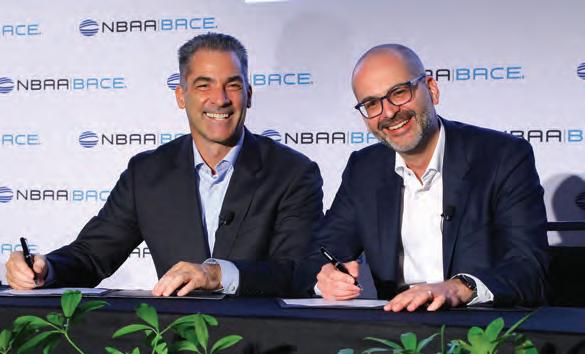
The Canadian manufacturer’s aircraft activity covers several areas, including prod uct testing and certification flights conducted in Montreal; shuttle flights for Global fam ily aircraft from Toronto to Montreal for
completion; customer demo flights from the OEM’s Hartford, Connecticut-based demon stration team; new aircraft certification flights from Bombardier’s Wichita flight-test center; and active service check flights from all of the company’s service centers worldwide.
“Bombardier’s decision will reduce annual greenhouse gas emissions from fuel use in its flight operations by approximately 25 percent,” said Jean-Christophe Gallagher, executive v-p of services, support, and corporate strategy
Finno Aviation Products is celebrating its 100th delivery of a Pratt & Whitney PT6A67P engine upgrade for the legacy Pilatus PC-12, the company announced on Monday at NBAA-BACE 2022.
While the engines are designed and built by Pratt & Whitney Canada (P&WC), Finno Aviation (Booth 4185) holds the FAA supplemental type certificate (STC) for the engine upgrade for legacy Pil atus PC-12s. The turboprop sin gle entered service in the 1990s and was originally powered by the P&WC PT6A-67B engine.
Introduced in 2006, the PC-12 NG comes equipped with the more powerful PT6A-67P engine. Upgrad ing the engines on legacy PC-12s brings the older aircraft’s performance parameters up to the standards of the newer model.
The -67P engine provides a 20 per cent increase in horsepower during climb and allows the aircraft to travel 15 knots faster during cruise. It also generates about 40 percent more elec trical power.
Finno , which specializes in PC-12 upgrades, started work ing on the PT6A-67P upgrade for legacy PC-12s in 2008. In 2012, the company received an STC for the upgrade and com pleted its first installation.
Other PC-12 upgrades offered by Finnoff include MT-5 and MT-7 propellers, IS&S ThrustSense autothrottle installations, adding P&WC’s flight acquisition storage and transmis sion system, electrical system upgrades, and True Blue Power’s TB40 lithium-ion battery. H.W.
for Bombardier (Static AD_310).
“This is a huge gain,” he said, adding the goal of the agreement was to reduce the company’s net greenhouse gas (GHG) emissions as fast as possible. By opting for the book-and-claim model, where the actual fuel is dispensed near its point of production, Bombardier negates any GHG emissions that would have been incurred through the transport of the actual SAF.
Signature Flight Support (Booth 4495) was the first FBO network to offer permanent sup plies of SAF starting in December 2020 at its San Francisco location. Last year at NBAABACE in Las Vegas, the company launched its Signature Renew book-and-claim program, which allows users to purchase SAF and receive environmental credits for its use even though the actual fuel may be dispensed thousands of miles away in an entirely different aircraft whose operator is not entitled to the credits.
“Over the last two years, Signature Avia tion has grown its sustainable aviation [fuel] supply points to 17 airports around the world, or just 10 percent of our total network,” said Signature Aviation CEO Tony Lefebvre. Today, the company dispenses 8 percent of the global production of SAF through those locations.
“While we work aggressively to expand the availability of sustainable aviation fuel, bookand-claim provides critical coverage to current gaps in the supply while immediately taking greenhouse gases out of the atmosphere,” said Lefebvre. He added that the investment in carbon reduction through book-and-claim is helping expand the supply of SAF.
In addition, the move is meant to send a clear signal throughout the industry, accord ing to Gallagher. The message is that “there is demand for SAF and we’re among the companies that are willing to go the extra mile to stimulate the market,” he concluded. z

DPI Labs and SkyCinema Aviation debuted at NBAA-BACE 2022 the world’s first air borne application of the Dolby Atmos immersive audio system, as well as DPI’s newest dotless remote phosphor LED Smartlights. Both the Atmos sound system and LED lighting are on display in a spe cially outfitted van at the companies’ booth (4895) where visitors can immerse them selves in the products.

Dolby Atmos allows up to 128 channels of audio to 64 independent speakers for in-theater applications, while the consumer version uses a smaller number of speakers.
“What we love about this system is that it’s perfect for VVIP retrofit installations,” said Jay McGrath, co-founder and managing part ner of UK-based SkyCinema Aviation. “We’re able to deliver a truly professional, immersive cinematic experience to the end customer at less than 15 percent of the cost of a full cabin audio replacement.”
A joint-engineering effort between Cali fornia’s DPI Labs and SkyCinema Aviation, the main theater area on the Boeing includes DPI Labs’ 65-inch OLED UHD ultra-thin 4K display and its SmartLink cabin management system, paired with a Dolby Atmos processor and 57 speakers situated around the cabin and above the viewers. The 65-inch 4K OLED display, introduced in 2020, is the largest and thinnest display available for aircraft today, according to the companies.
First introduced to cinemas in 2012, the most recent theatrical release featuring the audio technology is “Top Gun: Maverick.”
DPI also introduced its new dotless remote phosphor LED Slimline Smartlights, which provide homogeneous lighting for cabin wash, toe kick, and accent lighting. Unlike typical LED strip lighting where individual LED diodes cast their own light cones, dotless remote phosphor technology uses studio-grade royal blue LEDs to ener gize a coating of phosphor inside the strip, providing “seamless, uniform lighting con sistency,” said Greg DeSmet, DPI’s engineering manager.
The technology creates a smooth “dot-free” homogenous lighting product resembling traditional fluorescent tubes but with the ben efits of much smaller size, minimal energy consumption, and much longer life than even normal LED strip lighting, according to DPI.
Slimline joins DPI’s line of SmartLight LED strip lighting products, which use studio-quality flicker-free LEDs for cabin-lighting appli cations. SmartLights can be measured and cut-to-fit by MROs during installation providing a zero-lead time solution for both new aircraft installations, as well as quick fluorescent lighting retrofit replacements. DPI’s compact lighting power supply modules support inte gration with legacy cabin control systems. z
Desert Jet Center, a full-service FBO, maintenance provider, and charter operator at Jacqueline Cochran Regional Airport (KTRM) in Thermal, California, is now the latest member of the Titan Aviation Fuels-branded network.
“After a very thorough process, we found that Titan Aviation Fuels is the best fit for Desert Jet Center and our continued growth,” said Jared Fox, CEO of Desert Jet Center (Booth 4619). “After getting to know the Titan team and seeing their operation, we are confident that our new
partnership will benefit our customers, employees, and community.”
As it prepares for its peak season, Desert Jet—recently named as the Corporate Aircraft Association’s preferred FBO at KTRM—also adopted X1-FBO’s software to enhance its customer experience.
The move is part of the company’s commitment to embracing the lat est FBO technologies to improve service e ciencies. Paperless tracking of fuel loads and real-time notifications of reservations, flights, and ser vice requests all help personalize client interaction. C.E.
BAE Systems will design and develop the flight control computer for Supernal’s five-passenger eVTOL. On Monday at NBAABACE, the aerospace group said it will define the requirements and architecture for a light weight fly-by-wire system in partnership
with Hyundai Motor Group’s advanced air mobility subsidiary.
The flight controls for Supernal’s SA-1 eVTOL will need to be compact and support its advanced processing needs and autonomous functions. BAE said it intends to develop the system in a way that it could be easily adapted for use with other new electric aircraft.
Owners and operators of the Learjet 55C have a new flight management system (FMS) option— the installation of dual Avidyne Atlas units that allow pilots to fly fully-coupled LPV approaches. Florida Jet Center (Booth 3726) worked with Avidyne (Booth 1681) on the project, which required reconfiguration of the center pedestal to accommodate the EFIS mode select controls and the Dzus-mounted Atlas FMSs.
The modern Atlas units add many capabil ities in addition to LPV, LP, LNAV/VNAV, and LNAV-only approaches, including synthetic vision display and a moving map. Built-in Bluetooth connectivity allows for the trans fer of information between the Atlas FMSs and iPads running ForeFlight Mobile and Avidyne’s IFD100 app. Other features of Atlas include flight planning, radar and video display, fuel flow information, ADS-B In (weather and tra ffi c), and other pilotconfigurable options.
Even in aircraft with legacy EFIS avionics such as the Learjet 55C, Avidyne’s GPS Legacy Avionics Support connects navigation infor mation through the VOR localizer channel, making it possible for active flight plans to conclude with a GPS (RNAV) approach.

The Atlas FMSs are equipped with QWERTY keyboards and touchscreen displays and meet TSO C146c. The price for the dual Atlas sys tem for the Learjet 55C is $90,880.
“Atlas gives new life to these highly capa ble airframes without the high cost of a full flight deck replacement,” said John Talmadge, Avidyne v-p of worldwide sales, “and giving operators a whole host of new capabilities— and most importantly opening up hundreds of airports and runway ends with GPS-based LPV approaches.”
Supernal’s eVTOL is expected to fly 60 miles and cruise at up to 180 mph.

BAE Systems (Booth 3200), which has more than 40 years of experience in devel oping flight controls, will run the program from its new facility in Endicott, New York. “The development of advanced, high-integ rity controls is crucial to meet the demands of electric aircraft,” said Ehtisham Siddiqui, BAE’s v-p and general manager of controls and avionics solutions. “BAE Systems is harnessing its investment in electrification and expertise in flight-critical systems to advance sustainable aviation. We look for ward to working with Supernal to make this shared vision a reality.”
Supernal (Booth 2400F) said it expects to start the FAA type certification process for the SA-1 in 2024. Earlier this year, it announced plans to introduce a hydrogen-powered eSTOL aircraft.
Initially, the SA-1 will be flown by a pilot and will seat four passengers, although the company plans to eventually switch over to autonomous flights with a six-passenger version of the vehicle. It will be designed to cruise at up to 180 mph (290 km/h) and an altitude of 1,000 to 2,000 feet (300 to 600 meters), with a range of about 60 miles (100 km) on a single charge, with a recharge expected to take no more than five to seve n minutes.
BAE also specializes in power conver sion and energy management systems. The company is already working with two other eVTOL aircraft developers, Jaunt Air Mobil ity and Eve, as well as with General Electric on a NASA project to develop hybrid-electric propulsion systems.
This week, Supernal also announced the selection of Honeywell Aerospace to pro vide the SA-1’s avionics suite. Honeywell will provide its new Anthem integrated flight deck, which has already been chosen for eVTOLs being developed by Lilium and Vertical Aerospace. z
FAA acting Administrator Billy Nolen reaf firmed his agency’s commitment to safety and bilateral cooperation with the European Union Aviation Safety Agency (EASA) during a panel discussion Tuesday morning at NBAABACE 2022 with Patrick Ky, executive direc tor of EASA. “People have an expectation of safety no matter where in the world they fly or whatever they plan to fly on,” Nolen said during the first-day opening session.
“The relationship between EASA and the FAA has never been better,” said Ky, noting that the coordination, cooperation, and shar ing of information between the agencies,
Champion Air Airlines, which today special izes in sports team transport, essential in today’s world.
“Having some normalcy in their lives is crit ical,” Earnhardt said.
He followed his father’s example, buying an aircraft early in his career, and though Earn hardt rarely races anymore he still relies on business aviation. “Having the flexibility to move around the country is essential for me,” he said.
Earnhardt was aboard his Cessna Cita tion Latitude when it ran off the runway while landing in 2019, and while no inju ries resulted from the highly reported acci dent, the aircraft subsequently caught fire and burned. The episode wasn’t addressed during hi s presentation.
Earnhardt’s latest win: he’s just finished a children’s book, “Buster’s Trip to Victory Lane,” written for his two young daughters, who currently only care to read “Goodnight, Moon,” he said.
Tyson, interviewed by broadcast journal ist Lisa Starke, also has a lunar fixation, evi dent as he addressed topics from the NASA Artemis program, the Webb Space Telescope, asteroid deflection, UFOs, and more.
“We have to go back to the moon,” Tyson said of Artemis, whose first flight has been rescheduled for next month. Craters near
particularly at a recent International Civil Aviation Organization (ICAO) conference in June and its triennial assembly earlier this month, “was just absolutely perfect. It shows that we are working very well together.”
This commitment carries over to sus tainability and ICAO’s goal to bring global aviation to net-zero carbon emissions by 2050 and to shepherd advanced air mobil ity (AAM) into the world aviation community, said Nolen. Ky added that the FAA and EASA already have worked together to certify air craft engines to run on 50 percent sustain able aviation fuel (SAF) blends, are exploring

100 percent SAF certification in new genera tion engines, and continuing to evaluate the trade-offs between operational efficiency and sustainability. He said EASA is working to qualify SAF and monitoring how it is intro duced throughout Europe.
With regard to AAM, Ky said EASA plans to assist in the certification of these vehicles in time to transport passengers from Paris Charles De Gaulle International Airport to the city center during the upcoming Paris Olympic Games in 2024, including recent policy guidance on vertiport construction and certification and route assessment. “It’s a very complicated issue. But we are not talking about mass transport. We are talking about maybe a dozen vehicles that would fly every day,” he noted. M.H.
the lunar poles, “where the sun don’t shine,” could harbor water from eons of asteroid impacts that could sustain visitors from Earth, he said. Meanwhile, the infrared light the Webb telescope detects can find biomark ers for life in the atmosphere of exoplanets light years away.
Where would he suggest exploring next? “Everywhere,” Tyson said. “If you have an air plane, you want to go everywhere. That’s how I feel about the universe.”
Tyson’s new book, “Starry Messenger,” tracks the evolution of his thinking and insights about the cosmos. z
The challenges facing aviation’s decarboniza tion took center stage at the NBAA newsmak ers lunch on yesterday at NBAA-BACE.

A panel discussion hosted by journalist Miles O’Brien explored the hurdles and focus areas that will be needed to meet aviation’s stated goals. The industry has been work ing on improving efficiency for decades and has seemingly solved the easy problems but the remaining 20 percent of improvements needed is the tough part, according to Amanda Simpson, v-p of research and technology at Airbus Americas.
“Of the remaining work to be done, we esti mate there is probably 8 to 10 percent that’s on the operation side,” Simpson said, noting inefficiencies present in the system due to waiting to take off, circling at low altitude, or time of commercial transport waiting on the ground for a gate to open. “These are ineffi ciencies that one would think are the easy part to wring out of the system.”
While sustainable aviation fuel (SAF) is widely viewed as the most current and impactful solution, the current several million gallon a year production is still but a drop in the bucket compared to the 34 billion gallons needed by the industry.
“This is a problem of extraordinary scale,” said Erik Lindbergh, grandson of pioneer
Charles Lindbergh and chairman of the Lind bergh Foundation, which aims to spur decar bonization of aviation using incentive prizes.
Most SAF is presently produced from organic sources such as oil crops and waste fats, but Simpson sees the future as newlydeveloped and still very costly synthetic fuels. “Where you are not using biofuels, you are lit erally drawing fuel from the atmosphere. But all these things take energy.” She added that ramp-up will require coordination with the energy industry, which needs a “fundamental reshaping on a global scale.”
Jaiwon Shin, former associate administra tor of NASA’s Aeronautics Research Mission Directorate and current CEO of Supernal, Hyundai Motor Group’s advanced airborne mobility division, said the automobile indus try is also undergoing a sustainability change.
“There is a huge transformation happening from internal combustion to electric vehicles. Where are you going to get all that electricity?”
Regarding energy, with other power sources on the horizon to propel aircraft, House avi ation subcommittee chairman Rick Larsen (D-Washington) explained that airports need to now be thinking about their future infra structure investments. “If they’re not pouring [jet fuel] in the but they are pouring electric ity into the metaphorical tank, or hydrogen, that is a completely different ground infra structure than airports currently have.” z
Charles Alcock Curt Epstein Gordon Gilbert Mark Huber
Mario Pierobon Kate Sarsfield Peter Shaw-Smith Jerry Siebenmark
Hanneke Weitering Kait Wilson James Wynbrandt
PRODUCTION MANAGER – Martha Jercinovich
GRAPHIC DESIGNERS – John A. Manfredo, Grzegorz Rzekos
PHOTOGRAPHERS – David McIntosh
DIRECTOR OF VIDEO – Ian Whelan
CHIEF OPERATING OFFICER – Dave Leach
VICE PRESIDENT SALES & MARKETING – Karl H. Elken
EVENTS – Nancy O’Brien
ADVERTISING SALES
Michelle James – Midwestern U.S., Western U.S./Western Canada/Asia Pacific, +1 (520) 343-0236
Joe Rosone – Mid-Atlantic U.S./Southeast U.S./Caribbean/ Brazil, +1 (301) 693-4687
Diana Scogna – Europe/Middle East, +33 6 62 52 25 47
Victoria Tod – Northeastern U.S./Eastern Canada/Great Lakes U.S./United Kingdom, +1 (203) 733-4184
Yury Laskin – Russia, +7 05 912 1346
AUDIENCE DEVELOPMENT MANAGER – Eileen Silberfeld
MARKETING AND CLIENT SERVICES MANAGER – Lisa Valladares
SOCIAL MEDIA MARKETING – Zach O’Brien
SALES ADMINISTRATOR – Cindy Nesline
DIRECTOR OF FINANCE & HUMAN RESOURCES – Michele Hubert
ACCOUNTS PAYABLE – Mary Avella
ACCOUNTS RECEIVABLE – Bobbie Bing
U.S. HEADQUARTERS:
214 Franklin Ave., Midland Park, NJ 07432, +1 (201) 444-5075
Advertising Inquiries: +1 (201) 345-0085, adsales@ainonline.com
Circulation Inquiries: +1 (201) 345-0085 subscriptions@ainonline.com
WASHINGTON, D.C. EDITORIAL OFFICE: Kerry Lynch (business aviation) klynch@ainonline.com +1 (703) 969-9195
EUROPEAN EDITORIAL OFFICE: Charles Alcock – calcock@ainonline.com, Tel: +44 7799 907595
NBAA Convention News is a publication of the AIN Media Group, Inc., 214 Franklin Ave., Midland Park, NJ 07432; Tel.: +1 (201) 444-5075. Copy right © 2021 All rights reserved. Reproduction in whole or in part with out permission of AIN Media Group, Inc. is strictly prohibited. AIN Media Group, Inc. publishes Aviation International News, AINalerts, AIN Air Transport Perspective, Business Jet Traveler, BJTwaypoints, ABACE Convention News, Dubai Airshow News, EBACE Convention News, HAI Convention News, Farnborough Airshow News, FutureFlight. aero, LABACE Convention News, MEBA Convention News, Paris Airshow News, Singapore Airshow News, Mobile Apps: Aviation International News; AINonline. PUBLICATION MAIL AGREEMENT NO. 40649046 RETURN UNDELIVERABLE CANADIAN ADDRESSES TO: PIT NEY BOWES INTERNATIONAL MAIL, STATION A, P.O. BOX 54, WINDSOR, ON, N9A 6J5, returns il@imex.pb.com.
Wilson Leach Jennifer Leach English Karl H. Elken
Hubert Nancy O’Brien





























